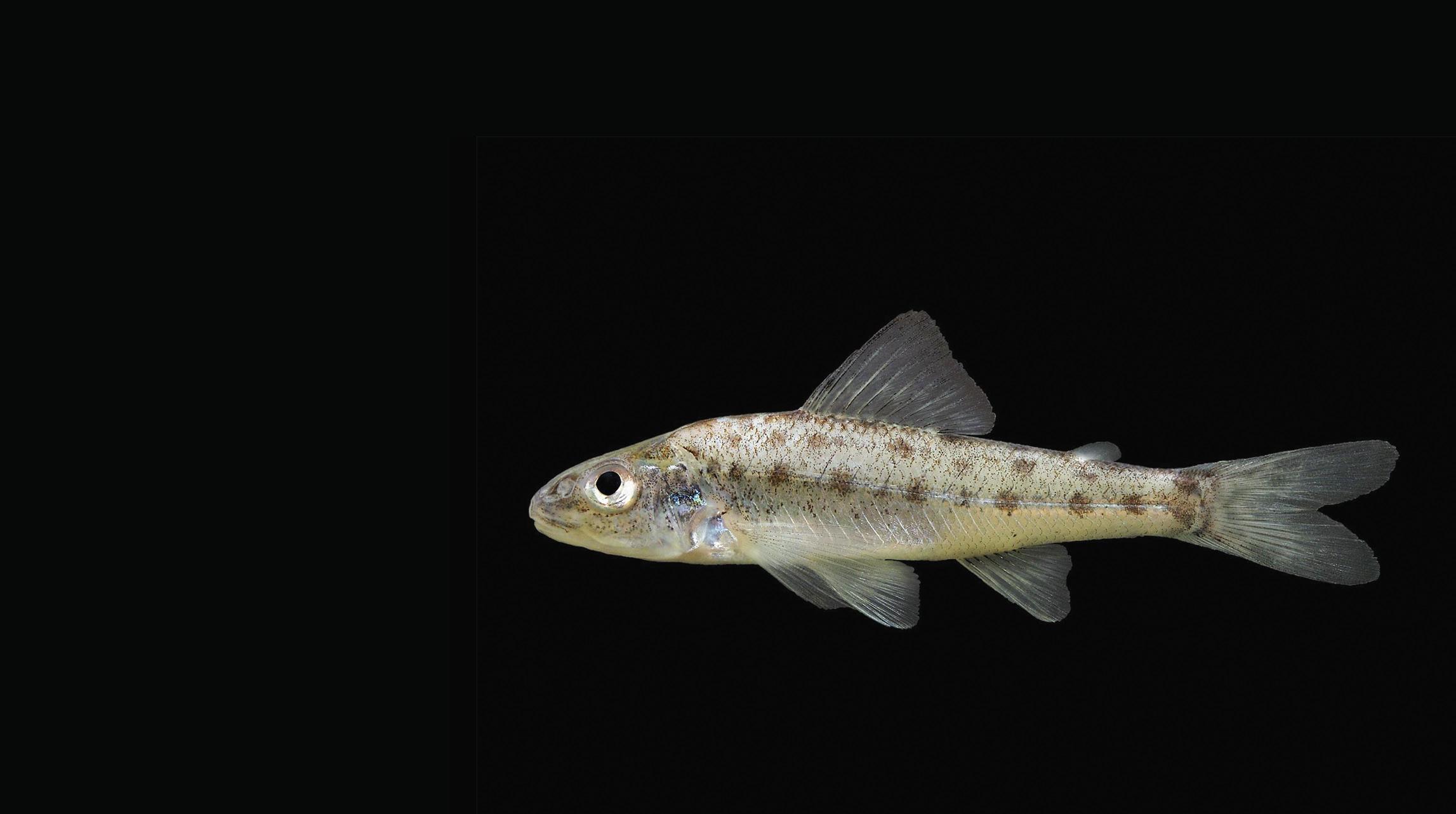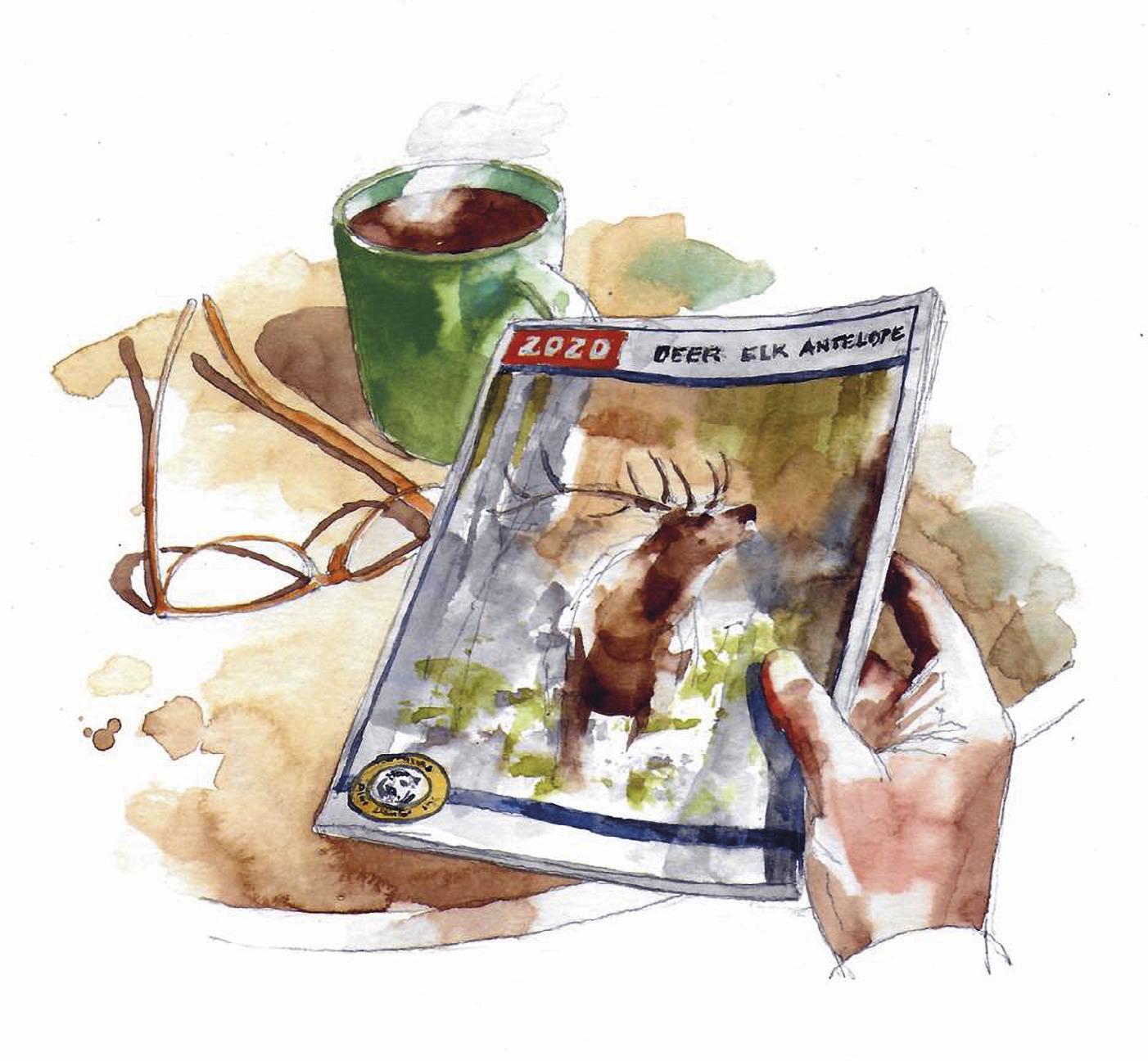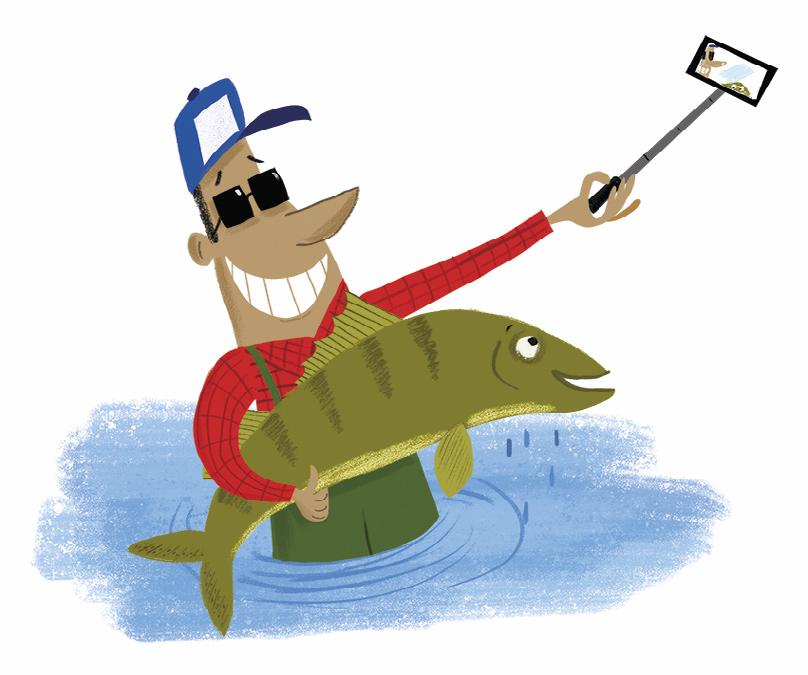
71 minute read
OUTDOORS REPORT

30 Average number, in millions, of fry (25) and fingerling (5) walleye that FWP hatcheries produce for stocking each year in lakes and reservoirs.
Prudent outdoor play
FWP recently joined the Recreate Responsibly Coalition, which promotes commonsense guidelines for having fun outdoors during the Covid-19 pandemic. Among the coalition’s guidelines: u Know Before You Go: Check the status of the place you want to visit. If it’s closed, don't go. If it's crowded, have a backup plan. u Plan Ahead: Prepare for facilities to be closed, pack a lunch, and bring essentials like hand sanitizer and a face covering. u Explore Locally: Limit long-distance travel and make use of local parks, trails, and public spaces. Be mindful of your impact on the communities you visit. u Practice Physical Distancing: Keep your group size small. Be prepared to cover your nose and mouth and give others space. If you are sick, stay home. u Leave No Trace: Respect public lands and waters, native and local communities, and private property. Take all your garbage with you. n

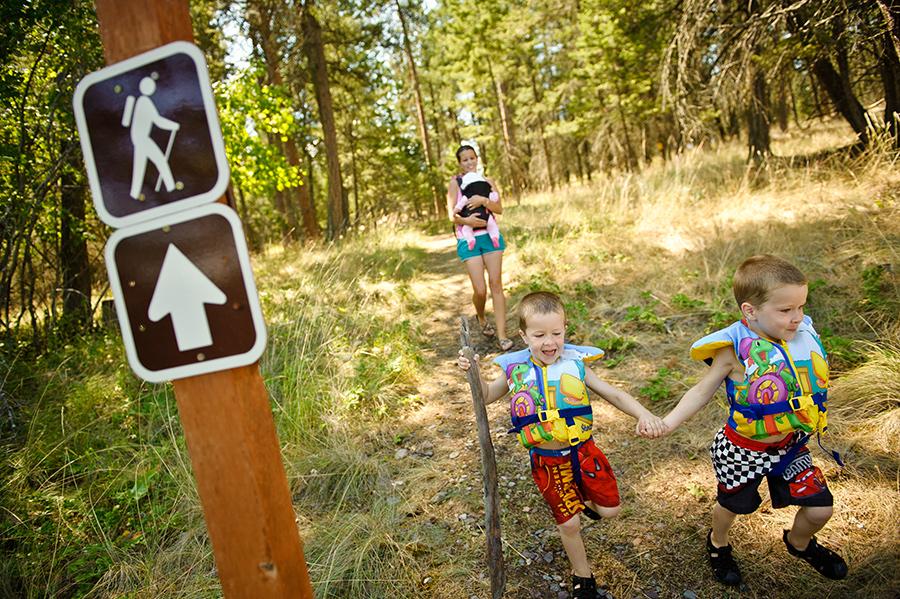
A pallid bat, one of 15 species in Montana, skims a pond at night in search of insects.
WILDLIFE CELEBRATIONS
2020 Bat Week goes virtual
For the third consecutive year, FWP Montana high school students, for the best and librarians across Montana are one- to three-minute video on why bats are teaming up to promote Bat Week. important. FWP will post top-ranked videos
Bat Week, held October 24-31 to corre- on its Facebook page and other social spond with Halloween, celebrates these media. The top-scoring video will win $500 winged mammals, their fascinating behav- donated by the Outdoor Legacy Foundation. iors, and their important role in nature Entries are due October 16. with lectures by bat experts, bat Lauri Hanauska-Brown, chief arts and crafts, and even bat- of the FWP Nongame themed baking. Wildlife Bureau, says she’s
This year’s programs encouraged that so many will be held online to librarians have emmaintain social dis- braced Bat Week. tancing protocols, says “Their outreach to local Amelea Kim, lifelong communities is making learning librarian for a huge difference in prothe Montana State Li- moting bat conservation brary. Participants can across Montana,” she says. watch videos starring the Bat Week events and Bat Squad—kids who talk programs are held throughabout all the cool things During Bat Week, kids can out the United States and bats do, why bats matter, receive free fun items like this Canada. Partners include threats facing bats, and “I’m Batty about Bats” sticker. the National Park Service, what people can do to help. Bat Week partic- Parks Canada, the U.S. Fish & Wildlife Servipants can also learn how to make bat capes, ice, and Bat Conservation International. bat houses, and insect-flavored or bat- For more information, visit batweek.org. shaped cookies. Crossword puzzles, word For Montana-specific information and finders, coloring pages, and other fun proj- details on the high school bat video compeects will also be available online. tition, visit FWP’s Facebook page at face-
New this year is a competition, open to book.com/MontanaFWP/. n
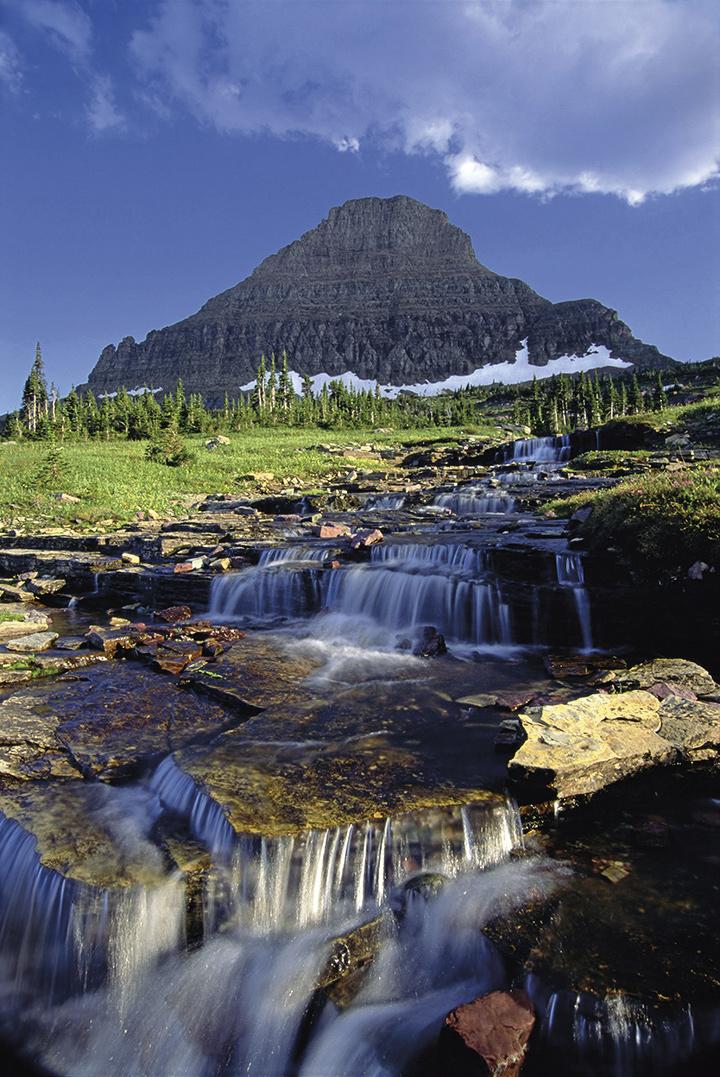

FISH CONNECTIVITY
Go fish, go!
The next time you catch a trout, consider how far it might have swum and how many obstacles it had to overcome to get there.
Earlier this year, FWP biologists documented a 21-inch rainbow trout migrating more than 150 miles. The 3.5-pound fish was first captured in the Thompson Falls fish ladder, part of a NorthWestern Energy hydropower facility on the Clark Fork River. It was fitted with a small ID marker and released upstream of the Thompson Falls Dam.
A month later, FWP biologists working on Johnson Creek, a tributary of the Blackfoot River, found the fish. It likely hatched in the creek years earlier and had returned to its natal waters to spawn, as rainbow trout do.
“This is the first documentation of a fish moving from the lower Clark Fork all the way up into the Blackfoot River system,” says Jon Hanson, a NorthWestern fisheries biologist.
For decades, trout in this river system faced myriad manmade obstacles to migration. Many barriers have been removed in recent years, though, and now fish are free to freely swim up- and downstream. “Trout need to move long distances to complete their life cycle,” says David Schmetterling, head of the FWP fisheries research program. “It takes a lot of work by a lot of organizations to remove the barriers and maintain clean, cold water so that can happen.” Various partner groups and agencies including Trout Unlimited and the U.S. Fish & Wildlife Service removed three culverts blocking fish passage on Johnson Creek. A road was decommissioned, reducing sedimentation in the creek, and land was acquired and conserved by Plum Creek Timber, The Nature Conservancy, and Lolo National Forest. Removal of Bonner and Milltown Dams by the U.S. Environmental Protection Agency eliminated two major fish barriers. The Thompson Falls fish ladder, completed in 2011, allowed the trout to access the lower Clark Fork River.
Schmetterling adds that rainbow trout aren’t the only fish species that migrate such distances. FWP biologists have also documented pallid sturgeon, cutthroat trout, blue suckers, bull trout, and sauger making journeys of over 100 miles. “To enhance or restore populations of native fish in our rivers, we have to consider scale,” he says. “Many species rely on huge connected water systems that flow across large landscapes.” n
Thompson Falls
Clark Fork River Over a period of 33 days, the trout traveled upstream 150 miles from Thompson Falls to
Johnson Creek, a Blackfoot
River tributary. Johnson Creek Missoula Blackfoot River Bitterroo t C l a r k F o r k
Great American Outdoors Act passes
Congress has fulfilled an outdoors recreation promise it made more than half a century ago to communities across the United States. On July 22, the U.S. House voted 310-107 to approve the Great American Outdoors Act, which secures permanent funding for the Land and Water Conservation Fund (LWCF). Voting 73 to 25, the U.S. Senate passed the bill in June. President Donald Trump signed the landmark legislation on August 4. Hailed as one of the most important conservation bills to pass in decades, the act will nearly eliminate a $12 billion National Park Service maintenance backlog and fully fund the LWCF for the first time since it was enacted in the 1960s. Though the program was permanently authorized last year, funding was not guaranteed. The Great American Outdoors Act will provide $900 million in federal oil and gas revenues annually for the LWCF, which funds new trails, parks, playgrounds, ball fields, and other outdoor recreation sites.
The LWCF, which is administered in Montana by the FWP Parks Division, has been used to purchase more than 800 recreation sites across the state. In western Montana, it has helped communities keep timberlands in production while protecting public access and habitat for elk and other wildlife. In eastern Montana towns, the federal program has paid for ball parks, park pavilions, and municipal swimming pools. It also helps pay for conservation easements that preserve open spaces and wildlife habitat on working ranchlands. n
The act will help with maintenance backlogs at Glacier and other national parks.
GROUNDED A golden eagle found in the Bitterroot Valley near Corvallis awaits treatment for lead poisoning at the Wild Skies Raptor Center east of Missoula. Initial blood analysis showed lead levels more than twice the lethal level, requiring weeks of chelation and physical therapy.
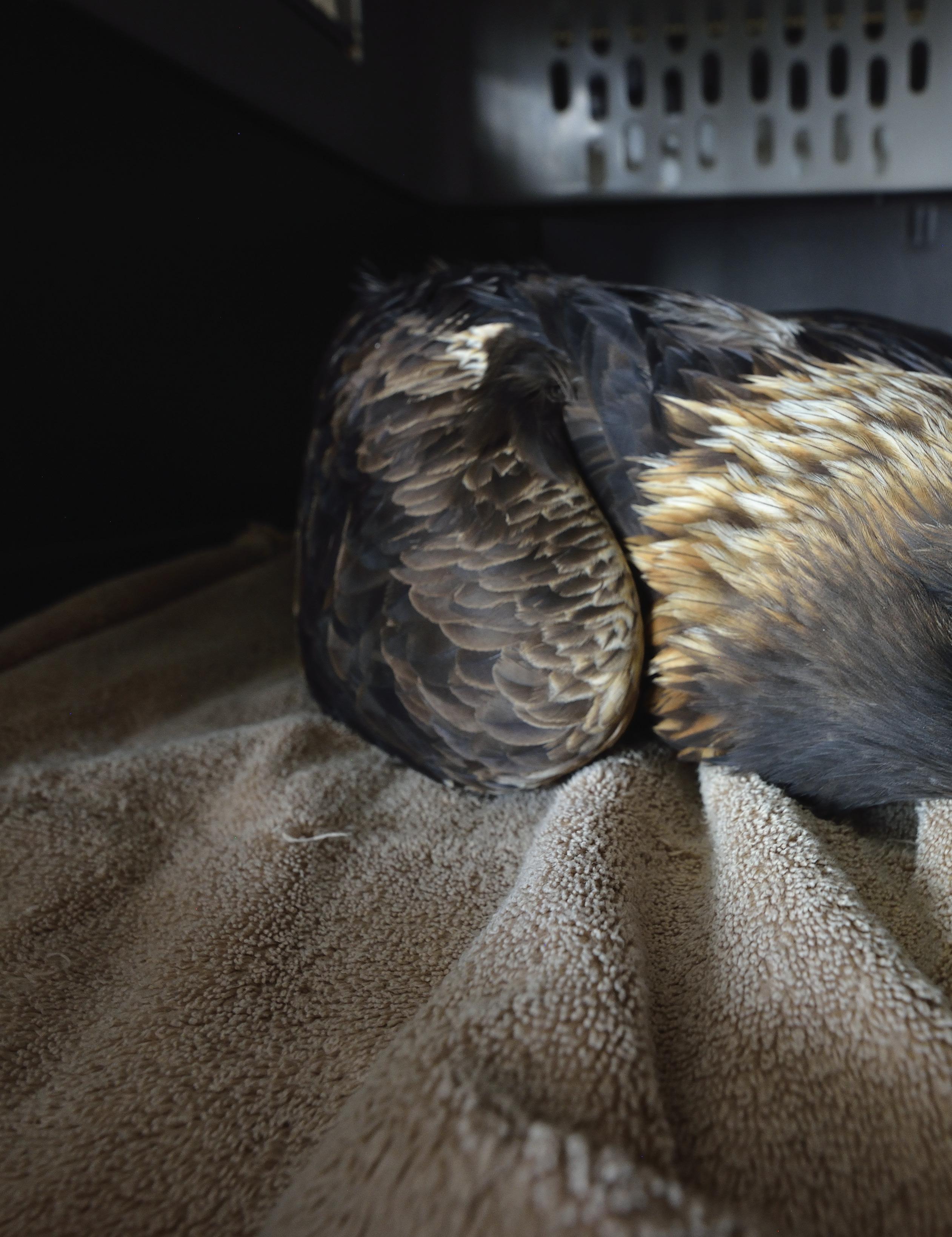
Choosing the UnleadedOption
Hunters are switching to copper and other less toxic bullets after learning how lead projectiles endanger eagles and other scavenging wildlife.
By Tom Dickson
JESSE LEE VARNADO n a grassy field on the MPG Ranch, located south of Missoula in the Bitterroot Valley,
Mike McTee arranges an unusual target. He lines up six one-gallon water jugs inside a rain barrel set on its side atop a folding table.
Then he paces off 70 steps, sets his Tikka T3 .270 Win. rifle on a rest, and fires a single 150-grain Remington Core-Lokt cartridge that pierces four jugs before stopping. McTee tips the barrel and pours the water and bullet residue trapped inside through a paper coffee filter.
What remains are the lead bullet, about 70 percent intact, along with more than 100 particles it shed while passing through the water jugs. “I show these fragments to other hunters, and they tell me, ‘I had no idea I was leaving all that in my deer or elk,’” says McTee, a big game hunter and a conservation scientist for the ranch who has given presentations on lead bullet fragmentation to rod and gun clubs across Montana. “When hunters field dress their animal and find the bullet, it seems mostly intact. They don’t see what remains in the meat and the gut pile.”
McTee repeats the experiment, this time firing an all-copper 130-grain Barnes TTSX cartridge. He drains the water into a filter and only the copper bullet, completely intact, comes out. Not a single fragment.
The jugs simulate a deer or elk (which, like all mammals, are mostly water). When a lead bullet strikes a big game animal, it expands, or mush-
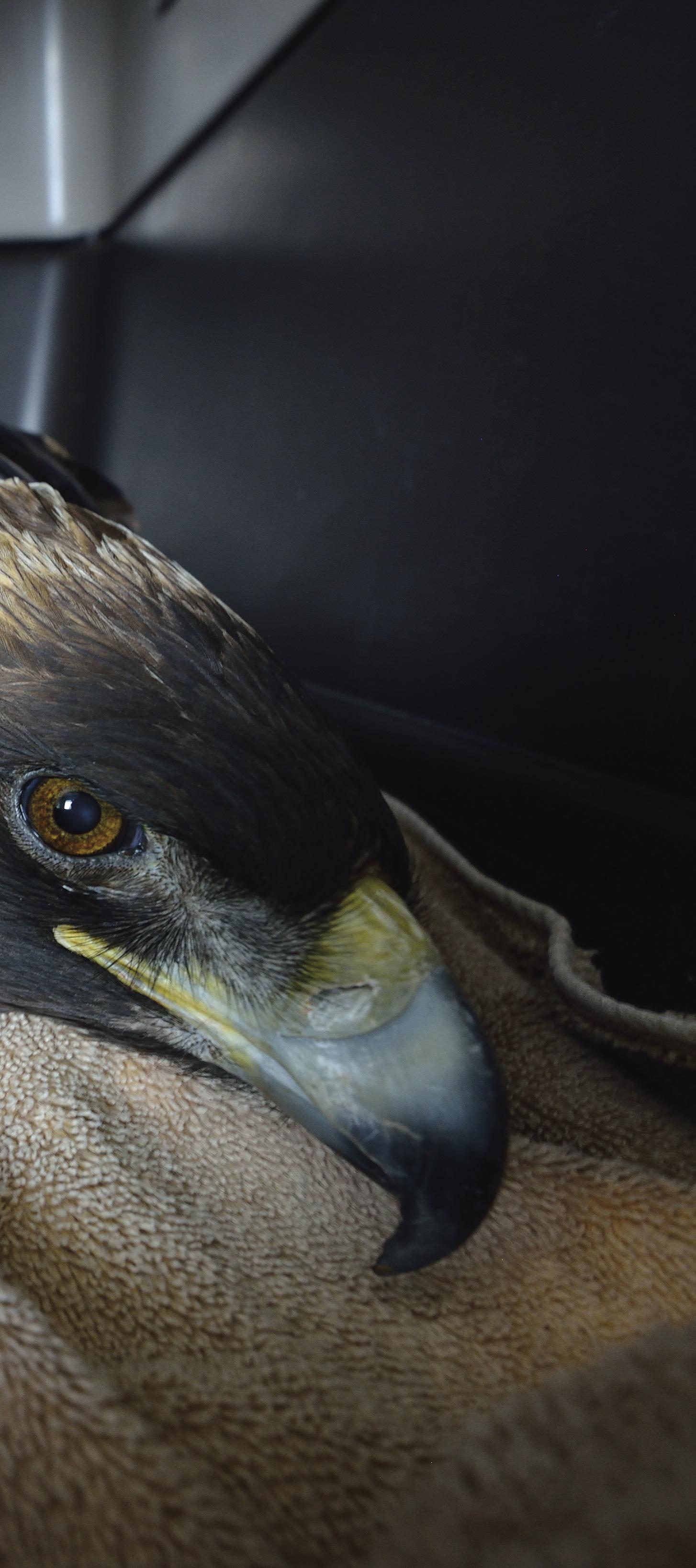
rooms while moving through the body, dropping small chunks and tiny lead pieces along the way. Some fragments veer a foot or more from the wound channel into the meat or viscera. The gut pile left after field dressing can be littered with lead particles.
Over the past two decades, wildlife biologists have learned that when golden eagles, bald eagles, and other scavengers feed on gut piles, they sometimes ingest that lead. Scientists have also found that ingested fragments nearly as small as the period at the end of this sentence can sicken, disable, and even kill nature’s most powerful winged predators. “If we hunters are leaving the remains of lead bullets behind in gut piles that then get into the food chain, that’s on us. We need to get ahead of the problem,” says Chris Parish, a big game hunter, co-founder of the North American Non-Lead Partnership, and a director at The Peregrine Fund.
Late last winter, veterinary technician Brooke Tanner at the Wild Skies Raptor Center, east of Missoula, received a leadpoisoned golden eagle found in the Bitterroot Valley near Corvallis. It was unable to stand and collapsed on the ground, both feet clenched tightly into fists. “She just sat there for days,” says Tanner, the rehabilitation center’s founder and director. “You’d walk by and she would make eye contact but couldn’t even lift her head. It was heartbreaking.”
Other lead-poisoned eagles brought to Wild Skies and Montana’s three other raptor rehab centers, in Bozeman, Kalispell, and Helena, have also displayed partial leg paralysis, muscle loss, tremors, and convulsions.
Blood analysis showed lead levels in the Corvallis eagle at 165 micrograms per deciliter. “That’s off the charts,” Tanner says, explaining that anything above 60 mcg/dl is considered potentially lethal.
Somehow that eagle was still alive.
LACED WITH LEAD
Golden eagles and bald eagles are inadvertently being poisoned by ingested lead across Montana. After finding research linking lead to bald eagle and California condor illness and death in the early 2000s, Rob Domenech and colleagues at the Missoulabased Raptor View Research Institute captured, over several years, 178 migrating golden eagles. After running blood tests, they found elevated lead levels in 58 percent of the eagles captured in the fall and 95 percent caught in the winter. “I was shocked,” says Domenech, the institute’s director.
Becky Kean, rehabilitation director of the Bozeman-based Montana Raptor Conservation Center, says that all eagles admitted to her facility are checked for lead toxicity. Ninety percent test positive for elevated levels. Most are treated with chelation therapy, which binds the metal to a special drug so it can be excreted through urine. Most of the raptors survive, but some don’t. “As a rehabilitator, it’s really hard when there’s nothing we can do to save an eagle,” Kean says.
Lead is a naturally occurring metal that shows up at low levels in all animals. It can enter the environment in several ways, such as via old discarded paint and lost fishing sinkers. But it appears that the lead responsible for poisoning eagles comes from gut piles left by big game hunters, as well as the carcasses of ground squirrels, prairie dogs, and other small mammals shot by varmint hunters. Kean notes that people start bringing lead-poisoned eagles to her facility in late October, when the big game hunting season begins. “We rarely see high lead levels in the summer,” she says.
A 2006 study by The Peregrine Fund X-rayed 38 white-tailed deer shot by hunters and found that 74 percent contained more than 100 visible lead fragments each.
Lead bullet
All-copper bullet
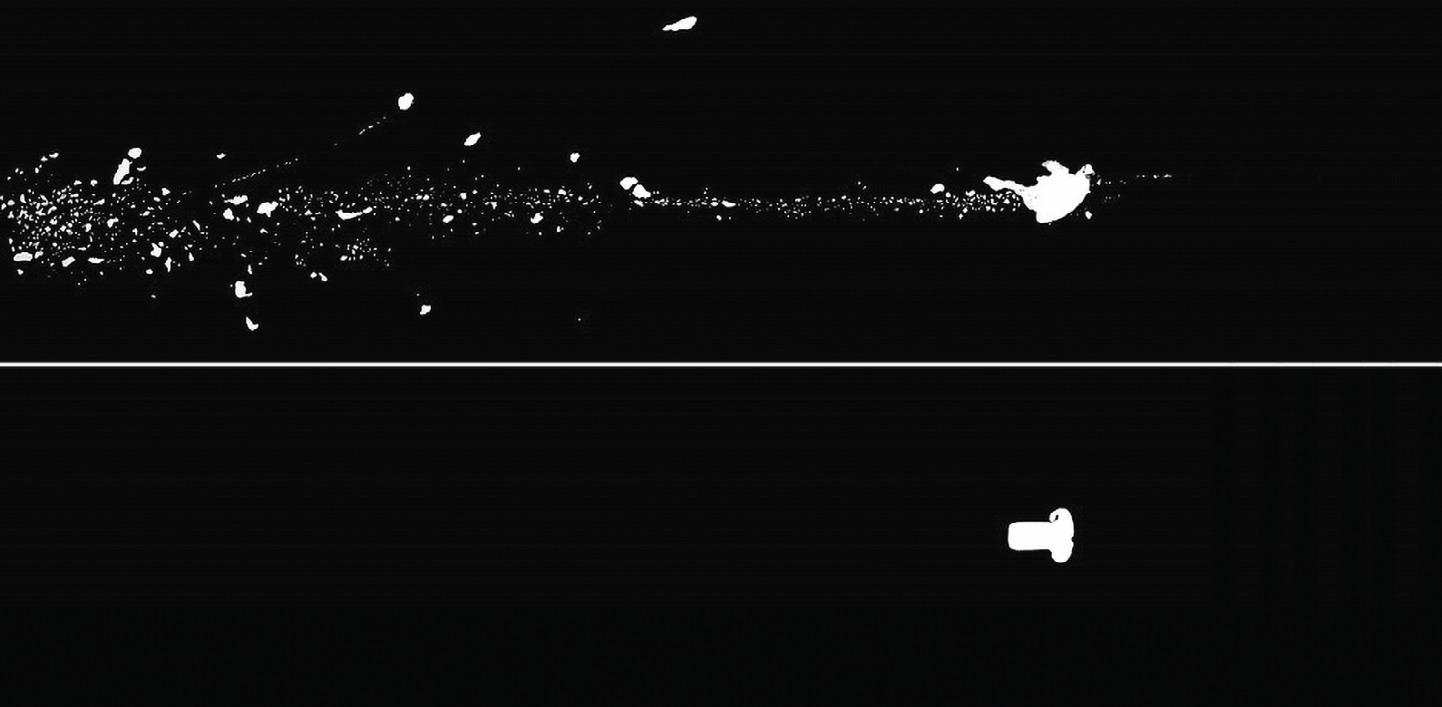
SHATTERED Above: X-rays of lead and copper bullets fired into gelatin show the splintering common in all-lead projectiles compared to the lack of fragmentation in a copper bullet. Right: A CT scan of a mule deer buck’s neck shot with a lead bullet shows how fragments disperse several inches or more within a carcass. The particles can end up in meat eaten by hunters and their families and in gut piles left behind and scavenged by golden eagles and bald eagles, species particularly susceptible to lead poisoning.


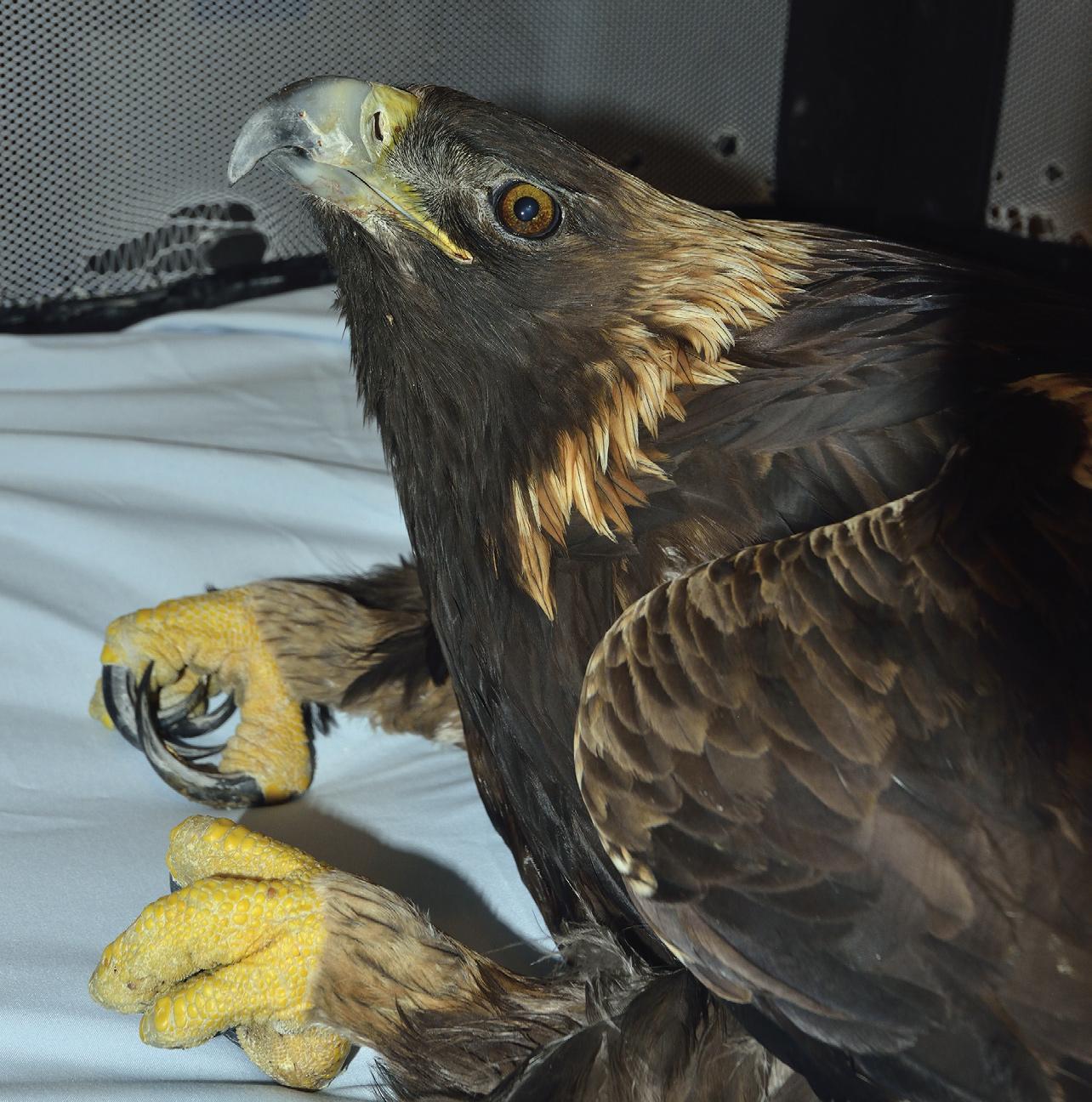
MALFORMED MAJESTY Above left: A golden eagle shows the clenched claws and resulting inability to stand that indicate lead poisoning. Wildlife rehabilitators and veterinarians believe that lead swells and fragments myelin nerve sheaths, causing foot paralysis. Above right: A bald eagle displays the drooping head associated with high lead levels. Lead-poisoned eagles may also exhibit wheezing, wing weakness, tremors, and convulsions.
A 2008 study by the Minnesota Department of Natural Resources found 82 to 141 lead fragments in each of the euthanized domestic sheep carcasses that researchers had shot with lead bullets. Many fragments were 9 to 11 inches from the wound channel.
To test fragmentation of small-caliber bullets used to shoot small game animals, researchers in Idaho and Montana found lead fragments in 65 percent of the 87 Columbian ground squirrels shot using .17 HMR and .22 LR ammo. “Varmint hunters tell me they are feeding the raptors,” says Jesse Lee Varnado, Tanner’s rehab assistant. “What they don’t understand is that they’re actually poisoning the raptors.”
PARTICULARLY VULNERABLE
American scientists have known that lead is toxic to birds for more than a century. But it wasn’t until the 1960s that biologists began linking health problems in waterfowl to the lead BBs used for duck hunting that ended up in shallow lakes. Ducks and swans picked up the spent shot, mistaking it for grit needed to digest food. In 1991, after studies showed that federally endangered bald eagles were dying after eating leadpoisoned waterfowl, the U.S. Fish & Wildlife Service banned lead for waterfowl hunting. That led manufacturers to develop the steel and other nontoxic loads that waterfowlers now use instead.
Worldwide, scientists have identified more than 130 wildlife species sickened by lead bullet fragments. Eagles are particularly vulnerable. Strong stomach acids that break down prey bones also dissolve lead particles, allowing toxins to more easily enter the bloodstream. The birds, which weigh only about 13 pounds, rarely die outright, instead succumbing to a slow death.
As a neurotoxin, lead impairs an eagle’s entire body, including sight, reproduction, immune function, foot strength, and judgment, making the birds more vulnerable to predation, starvation, disease, and collisions with objects. “Let’s say a lead-impaired eagle is feeding on a roadkill deer, and a car comes along at 70 mph,” says Tanner. “These large birds are already slow to take off, so adding even a slightly delayed reaction time means it’s more likely to get hit.”
Domenech suspects that neurological impairment may also cause eagles to scavenge more than usual. “An eagle that can’t hunt effectively has to feed on gut piles— where it then ingests even more lead, making it even harder to hunt.”
Eagle experts can’t determine what all this means on a population scale. Domenech notes that habitat loss, declining prey populations, collisions with vehicles, and illegal shooting remain the major factors that may be—scientists still don’t know for sure—limiting golden eagle population growth. “But lead toxicity doesn’t help, that’s for certain,” he says.
Golden eagle tallies in Alberta and Montana
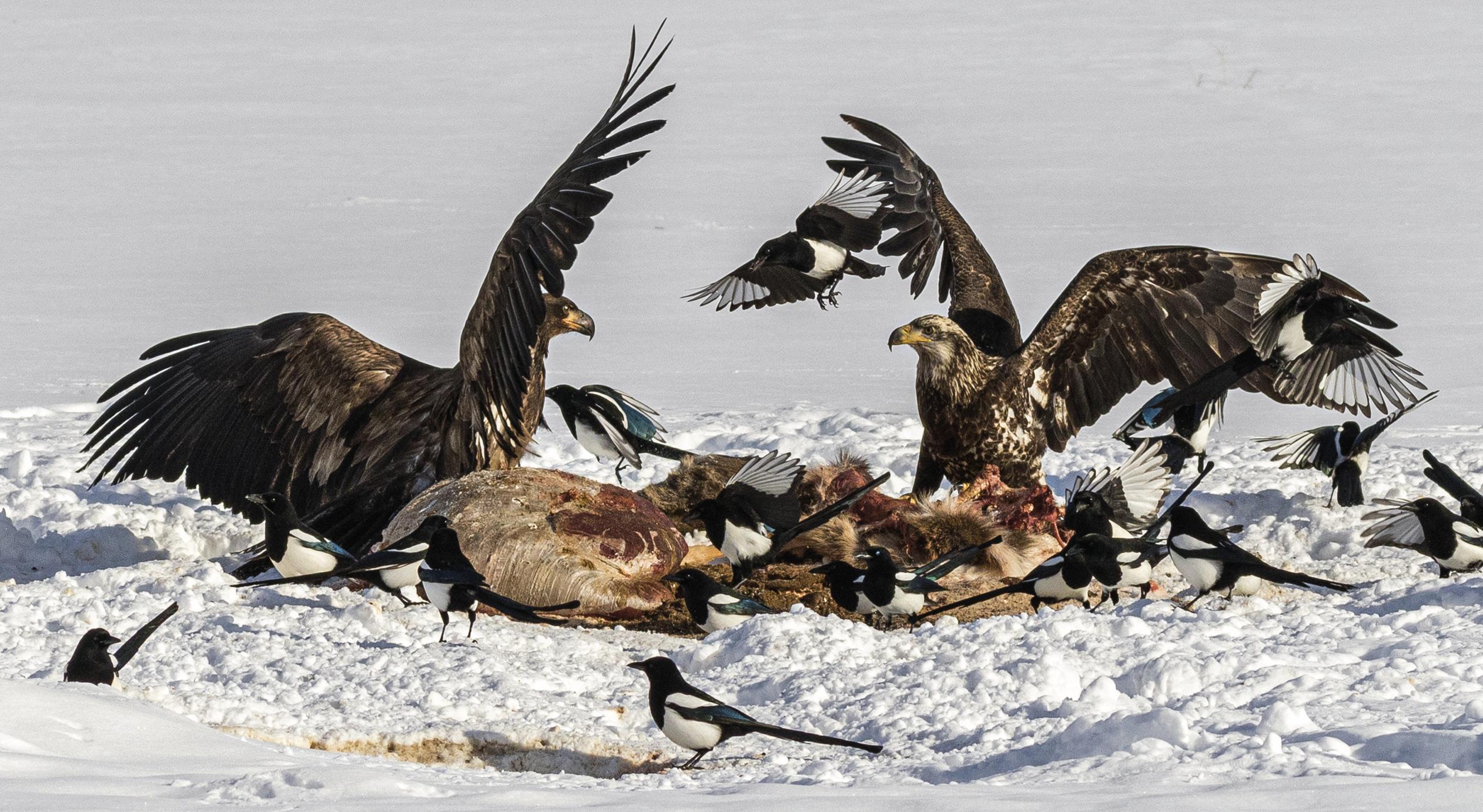
DANGEROUS DINING Golden eagles, bald eagles, and corvids like magpies and crows commonly feed on the occasional deer and elk shot but not recovered by hunters. Posing a greater risk are tens of thousands of deer and elk gut piles, many laced with lead particles, left behind by hunters each fall.
dropped 30 to 50 percent between the early 1990s and the 2010s before leveling off at that reduced level. Western Montana is a major migration corridor, especially along the Rocky Mountain Front, where tens of thousands of eagles fly south from Alaska and northern Canada through the state each fall. “Based on our sampling, it’s likely that most of those eagles have dangerous levels of lead in their systems. It’s a major concern,” Domenech says.
A CASE FOR COPPER
A growing number of hunters who share that concern—and worry how lead may affect their own health (see sidebar on page 15)— are switching to all-copper or copper-alloy bullets. Urging them on is the North American Non-Lead Partnership (NANP), a coalition of several western wildlife agencies including the Utah Department of Natural Resources and conservation groups such as the Montana Wildlife Federation and Backcountry Hunters and Anglers. The NANP sets its sights only on lead bullets used for hunting, not target shooting. “Our only concern is with bullets that end up in the food system used by scavenging raptors and other wildlife,” says Parish, the NANP co-founder. He explains that shooting ranges concentrate lead either indoors or in dirt piles where wildlife rarely feed.
The group does not support lawsuits or ballot initiatives aimed at banning lead. “We adamantly oppose litigation or legislation that would restrict any type of ammo. What we advocate is a completely voluntary approach to switching,” Parish adds.
A ban wouldn’t be possible in Montana anyway. In 2011 the state legislature prohibited the Montana Fish and Wildlife Commission, which regulates hunting ammunition and firearms, from placing restrictions on lead bullets.
Craig Knowles, a hunter who runs a bison ranch near Townsend with his wife, switched to all-copper bullets 15 years ago. “We were concerned about lead toxicity in wildlife and in the venison we eat,” he says. Knowles says that at first he was skeptical of copper’s efficacy. But he quickly changed his mind once he began dropping deer with single shots using his .270 Win., just as he had with lead. “We also use copper bullets for field slaughtering our bison. Again, great results,” Knowles says.
Jim Chaffin of Missoula agrees. The retired plumber switched to all-copper for his .338 and .300 Win. Mag. rifles six years ago after seeing X-rays of deer and elk carcasses laced with lead bullet particles. A demanding benchrest shooter, Chaffin says the thousands of rounds he has shot at the range have proved to him that copper bullets are plenty accurate for deer or elk.
Copper bullets have been around since the mid-1980s, when Barnes Ammunition developed an all-copper projectile with a hollow nose that expanded into four petals upon hitting a big game animal. For years, hunters had been frustrated that soft lead bullets broke up on impact, losing up to 40 percent of their mass and thus reducing penetration and lethality. Because premium allcopper loads retain 95 to 100 percent of their mass while expanding to twice their initial diameter, many ballistics experts say they generate greater killing power.
Voluntarily switching from lead is a chance for hunters to step up to another conservation challenge.”
Copper cartridges cost the same as premium lead bullets, though more than bargain all-lead bullets. Twenty years ago, nonlead cartridges were available only for a few calibers, but they now come in everything from the copper-tin composite .22 Hornet used on small game to the all-copper 260-grain .375 H&H favored by many African cape buffalo and Alaskan brown bear hunters. More than 60 ammunition manufacturers across the United States now sell nonlead bullets.
Some hunters who’ve switched continue to use lead at the range for fun and practice, then bring out the copper loads just before hunting season begins. For a skilled hunter who needs only one or two shots to kill an elk or deer, a box of 20 copper bullets can last years.
Copper can poison humans and wildlife, especially in high concentrations in drinking water. But the relatively few fragments left in animal carcasses by all-copper bullets don’t appear to sicken scavenging raptors or enter their bloodstream. A 2011 study by the U.S. Geological Survey that fed tiny copper pellets to American kestrels concluded that the metal did not harm the small raptors.
CARING ABOUT WILDLIFE
For a while, it looked like the Corvallis eagle recovering at the Wild Skies Raptor Center would survive. After two weeks of administering chelation therapy, Tanner began massaging the bird’s legs and gently opening and closing its clenched feet. Soon the eagle could stand, then take short flights attached to a tether. Two months after it arrived, the eagle was fitted with a satellite transmitter and released at the MPG Ranch.
Scientists followed the eagle for two months as it flew south into Idaho and back to the Bitterroot Valley. Then its signal stopped moving for several days, indicating the bird had died. A toxicology report determined chronic lead exposure as well as exposure to rodent poison. “This is so disappointing. These poor birds have so much working against them,” Tanner says.
When Parish hears such stories about lead-sickened eagles, he hopes his fellow hunters will see how easy it is to prevent raptor deaths and demonstrate their conservation ethic. “Historically, we hunters have been willing to take action on behalf of wildlife,” he says. “Voluntarily making the switch from lead to copper is a chance for us to step up to another conservation challenge,” he says.

FULLY INTACT Comparison of a copperjacketed lead bullet and fragments after firing into water jugs, and a polymer-tipped allcopper bullet that retained 100 percent of its mass in the same test.
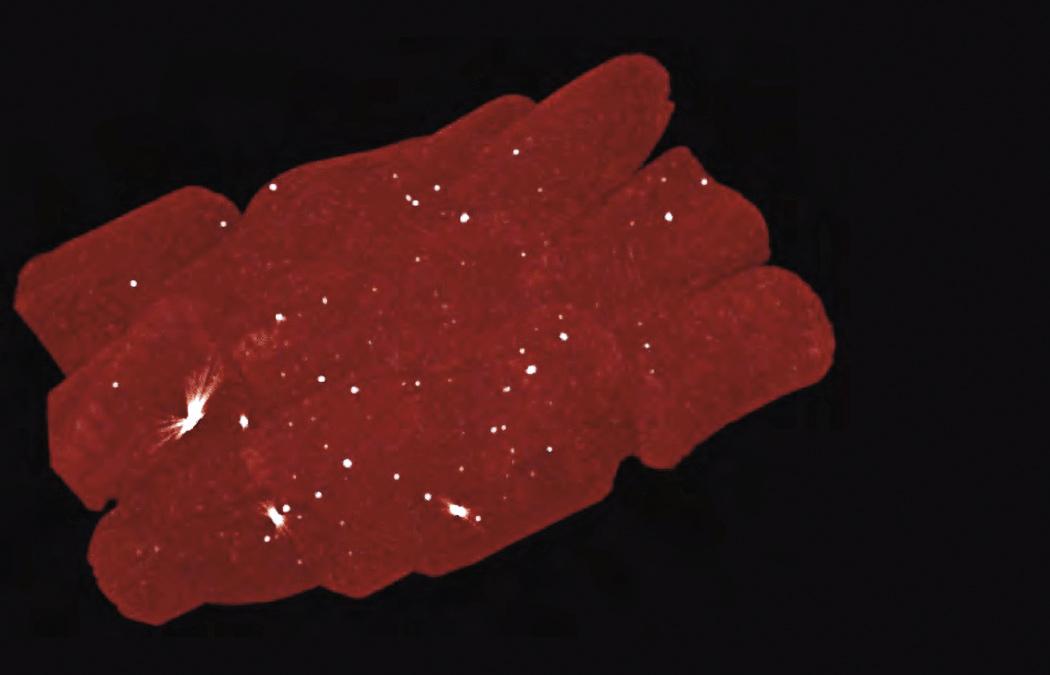
Lead is a heavy metal that’s harmful to both humans and animals. Lead exposure is especially dangerous to infants and children, including pregnant women and developing fetuses. According to the Centers for Disease Control and Prevention (CDC), there is no safe blood lead level in children. Children exposed to even low levels of lead can have decreased mental development that affects learning, intelligence, and behavior. Exposure during pregnancy can result in premature birth. In adults, accumulating too much lead can cause brain, kidney, and cardiovascular damage, reduced fertility, and cancer. Since the 1970s, lead has been banned in paint, children’s toys, water pipes, and gasoline.
The health effects of ingesting lead from bullet fragments while eating venison are not well understood. Nor do scientists know how much lead from bullet fragments is absorbed into the bloodstream of adults or children. However, there is no doubt that people who eat venison from deer or elk shot with lead bullets can ingest lead, often too small or soft to be noticed.
A 2008 study conducted by the Minnesota Department of Natural Resources surveyed the presence of lead fragments in commercially processed venison. In a sample of 1,029 packages of ground venison and 209 packages of whole-cut venison, 27 percent of the ground and 2 percent of the whole-cut meat contained lead fragments.
A study by the Wisconsin Department of Natural Resources that same year found elevated levels of lead in 15 percent of 199 commercially processed samples of venison and 8 percent of 98 hunter-processed samples.
Despite the lack of conclusive evidence linking major health problems with consuming deer and elk shot with lead bullets, more and more hunters are playing it safe by switching to copper and other nonlead projectiles. “We eat venison because we want healthy, organic meat,” says Pam Knowles, who runs a bison ranch with her deer-hunting husband near Townsend. “Why would we want to knowingly add lead to that?” —Tom Dickson
PHOTO: UNIVERSITY OF NORTH DAKOTA SCHOOL OF MEDICINE A CT scan of twenty 1-pound venison packages showing lead fragments (white).
PREHISTORIC-TIME-LAPSE PHOTO A natural stone bridge at Makoshika State Park near Glendive shows off hidden colors when lit by a photographer’s flashlight and headlamp at night as he moves past the formation (he’s standing in the photo’s far upper right corner). The greens and other hues picked up by his camera lens during a three-minute exposure show what the area might have looked like millions of years ago when stegosauruses and other dinosaurs lived there.



Iwouldn’t have been surprised if a Sleestak slithered up behind me and tapped me on the shoulder. Hiking at Makoshika State Park near Glendive triggered not only flashbacks to those reptilian humanoids and other characters from my favorite childhood show—the 1970s Land of the Lost—but also the awe and curiosity of a child exploring a natural playground full of scientific discovery.
During a recent visit, I learned of possible reasons why T. rex had such small arms (to slash at prey held close or to grasp a partner while mating), why ankylosaurus is considered one of the dumbest dinosaurs (it had the smallest brain-to-body ratio), and which extinct mammal park ranger Brenlee Shipps would be if that were a possibility (a giant ground sloth). “Sloths are incredible creatures we should all aspire to be,” says Shipps while leading a group of 10 park visitors. “We could all stand to slow down, eat a leaf, and nap in a tree once in a while.”
Ignoring Shipps’s advice, at one point I laughed and screamed while I slid down a wet, slippery clay trail, mud caking my socks and splattering my teeth. I cheered with about 200 other people at the opening credits of the 2009 animated movie, Ice Age 3, during a nighttime screening at an outdoor amphitheater. And I slept in a tent under a sturgeon moon—the first full moon of August, named for the time of year when sturgeon were once caught in abundance. My 16-year-old son says he has outgrown dinosaurs, but during my trip to Makoshika, I felt like I was the kid.
PREMIER PARK
The word Makoshika (mah-KO-shi-kuh) comes from the Lakota Maco sica, meaning “bad land” or “land of bad spirits.” No wonder the moniker stuck. Vegetation here is sparse and in places nonexistent. Rainfall is rare. The caprocks, pedestals, natural bridges, and other eerie rock formations look like the surface of Mars.
But in fact, the only thing “bad” about these lands, situated near the North Dakota border, is that they are so far from most Montanans. It takes a day or more for residents of Helena, Missoula, Kalispell, or Great Falls to reach Makoshika, which at more than 11,000 acres is Montana’s largest state park.
But proximity is no problem for out-of-state visitors from North Dakota, Minnesota, and points beyond, who whiz past the park on their way to the Rocky Mountains. With a quick detour off Interstate 94, visitors can experience Makoshika’s starkly beautiful scenery and moments of quiet and peace where the only sound comes from distant prairie winds over vast, gray, hardened sand ridges.
Makoshika is one of the state’s top tourism destinations. In 2017, USA Today named Makoshika as Montana’s No. 1 attraction. The park draws close to 100,000 visitors each year who come for the prehistoric otherworldliness of the terrain; to see the fossil remains of T. rex, triceratops, and the dimwitted ankylosaurus; and, if they are adults like me, to tap into their inner dinosaur-loving child.
The best way to learn about the region’s legendary dinosaur heritage is during the park’s weekly paleo tour, known as the “Paleo Experience.” The tour begins at the visitor center, continues to the paleo lab (where visitors can hold fossils), and ends with a hike to partially exposed hadrosaur vertebrae on the Diane Gabriel Trail, named in honor of the late Museum of the Rockies paleontologist who conducted dinosaur research at Makoshika.
During our tour, Shipps passes around a box and invites visitors to hold the contents. “What do you have in your hands?” she asks.
A choir of kids answer in unison, “Shells!”
“Right. But why do we have shells here?” Shipps asks. The kids are stumped. Makoshika is 1,500 miles away from the nearest ocean.
That wasn’t always the case, Shipps explains. Sixty to 100 million years ago, Makoshika was part of the Western Interior Seaway, which existed from the mid- to late Cretaceous period into the early Paleogene period and divided North America into two large landmasses. Shipps says that the park is one of the few places on Earth to see the Cretaceous-Paleogene (K-Pg) boundary. (The K-Pg abbreviation is derived from Kreide—German for “chalk,” and the abbreviation for the Paleogene period.) The K-Pg boundary is a thin band of rock associated with the period’s extinction event, which killed off the world’s dinosaurs. “Some scientists believe it was caused by a giant meteor striking Earth and causing an ecological change, most likely a massive cooling, that led to their extinction,” Shipps explains.
In other words, at Makoshika you can see and even touch possible evidence of the moment dinosaurs disappeared. Wolf Point visitor Max Ludwig, 11, peppers Shipps with questions, correctly
SCENIC CINEMA Top: With a natural backdrop as beautiful as a movie sunset, visitors watch Ice Age 3 at the park’s outdoor amphitheater. The park also holds ranger programs and Shakespeare in the Park plays at the amphitheater, which seats 200 people. Bottom: In the park’s visitor center, a family meets some of the region’s original inhabitants: a T. rex (foreground) donated by the Museum of the Rockies and a triceratops discovered at the park. Roughly 95 percent of the fossils displayed came from Makoshika.
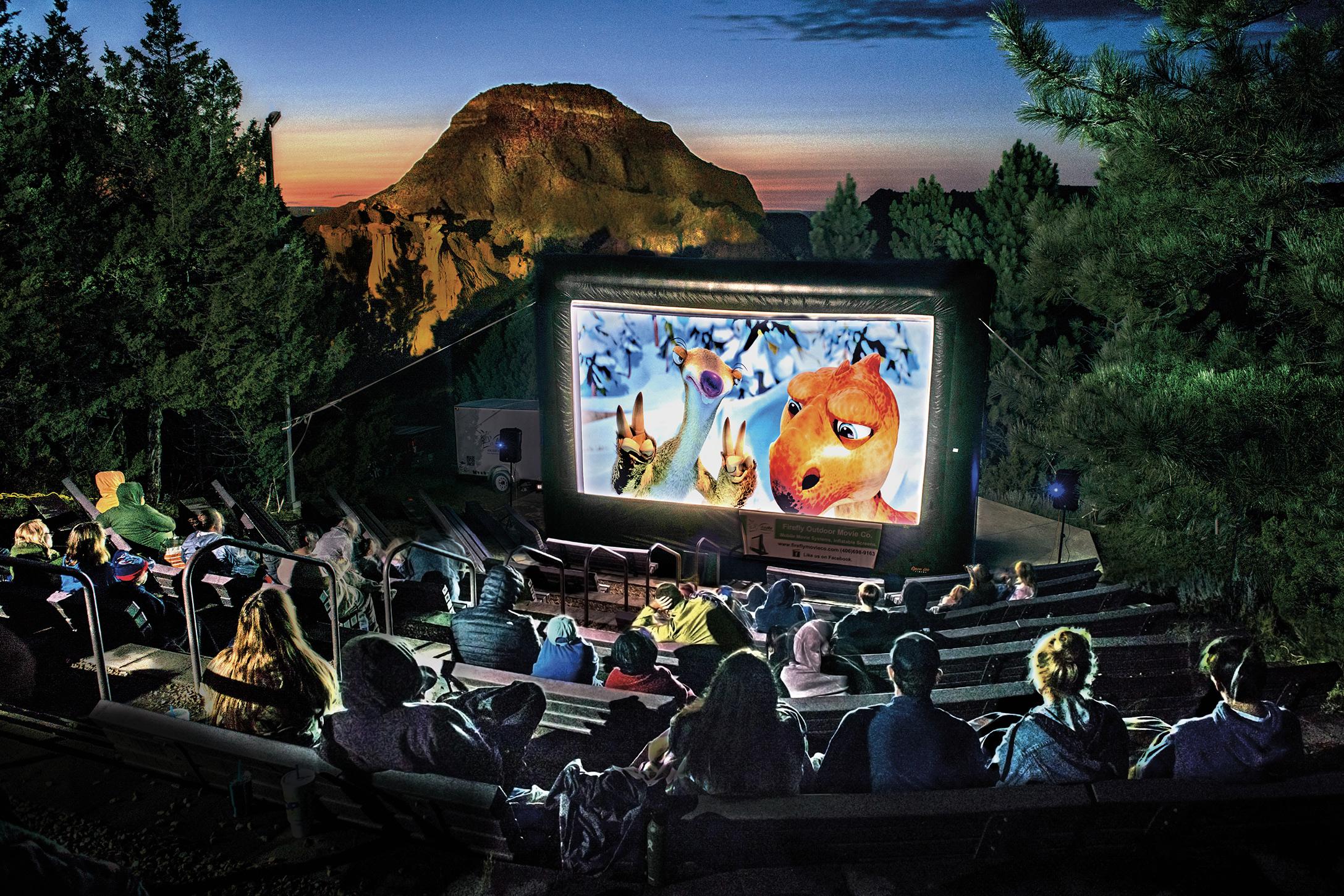
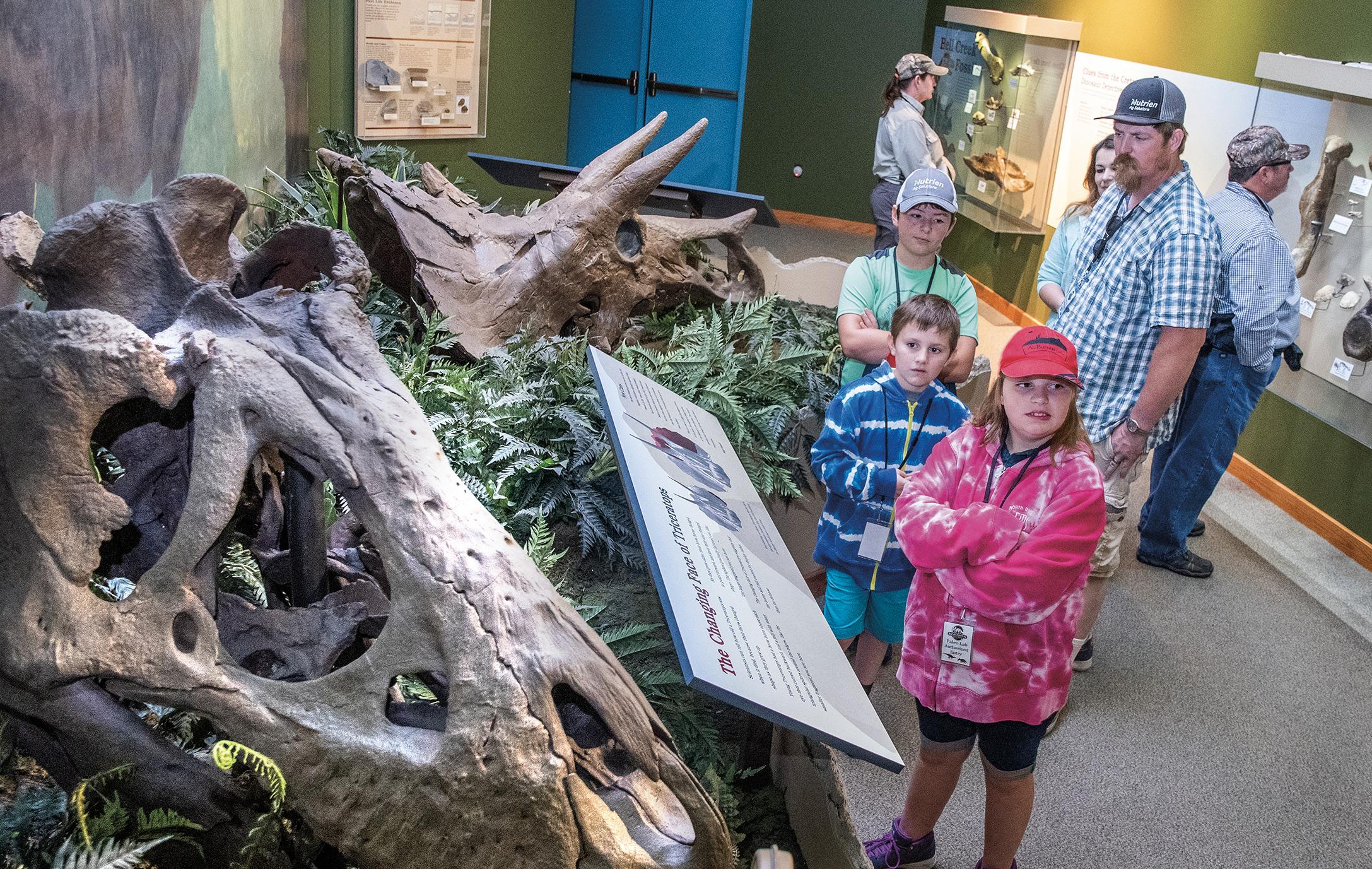
pronouncing words like “pachycephalosaurus” that are far beyond a grade schooler’s typical vocabulary. “Max has wanted to be a paleontologist since he was in preschool when he couldn’t even pronounce ‘paleontologist,’” his mother explains. When the paleo tour stops at an enormous cast of a T. rex skull, the loquacious Max is speechless. Though not discovered in the park, the skull was found in Montana in one of Gabriel’s other digs.
In 1991, a 5.5-foot-long, 600-pound juvenile female triceratops skull was unearthed in the park and is now displayed in the visitor center. And in 1997, a thescelosaurus skeleton, considered the largest and most complete of its kind, was found on a Makoshika expedition led by Jack Horner. Horner is the recently retired paleontology curator at Bozeman’s Museum of the Rockies and technical advisor for all five Jurassic Park movies. Museum of the Rockies researchers recently uncovered yet another triceratops horn at Makoshika.
Because of its rich and extremely visible prehistoric heritage, Makoshika is one of the highlights of the Montana Dinosaur Trail, a series of 14 museums and parks across the state that feature exhibits of Montana’s treasure trove of dinosaur fossils.
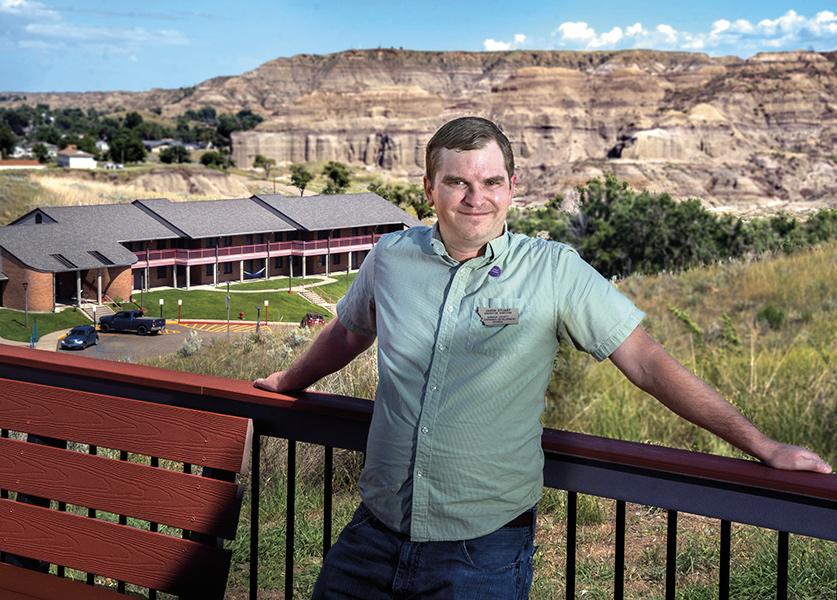
PACKED WITH OPPORTUNITIES
State park manager Chris Dantic lives at Makoshika with his wife and two sons. “It’s a great place for the boys to grow up,” he says. Not only do they get to live in an 11,000-plusacre outdoor classroom, the Dantic boys can hike the park’s 11 established trails, play disc golf on the nine-hole professional course, participate in park events such as campfire programs and the June Buzzard Day Festival, and attend plays by Montana Shakespeare in the Park and movies and other performances at the amphitheater.
Visitors also use the park’s 1,800-squarefoot picnic shelter, 3-D archery range, and nine miles of paved, lightly trafficked roads perfect for cycling.
According to Dantic, the park is home to mule deer, pronghorn (antelope), and 140 bird species including golden eagles and turkey vultures. The wildlife live among
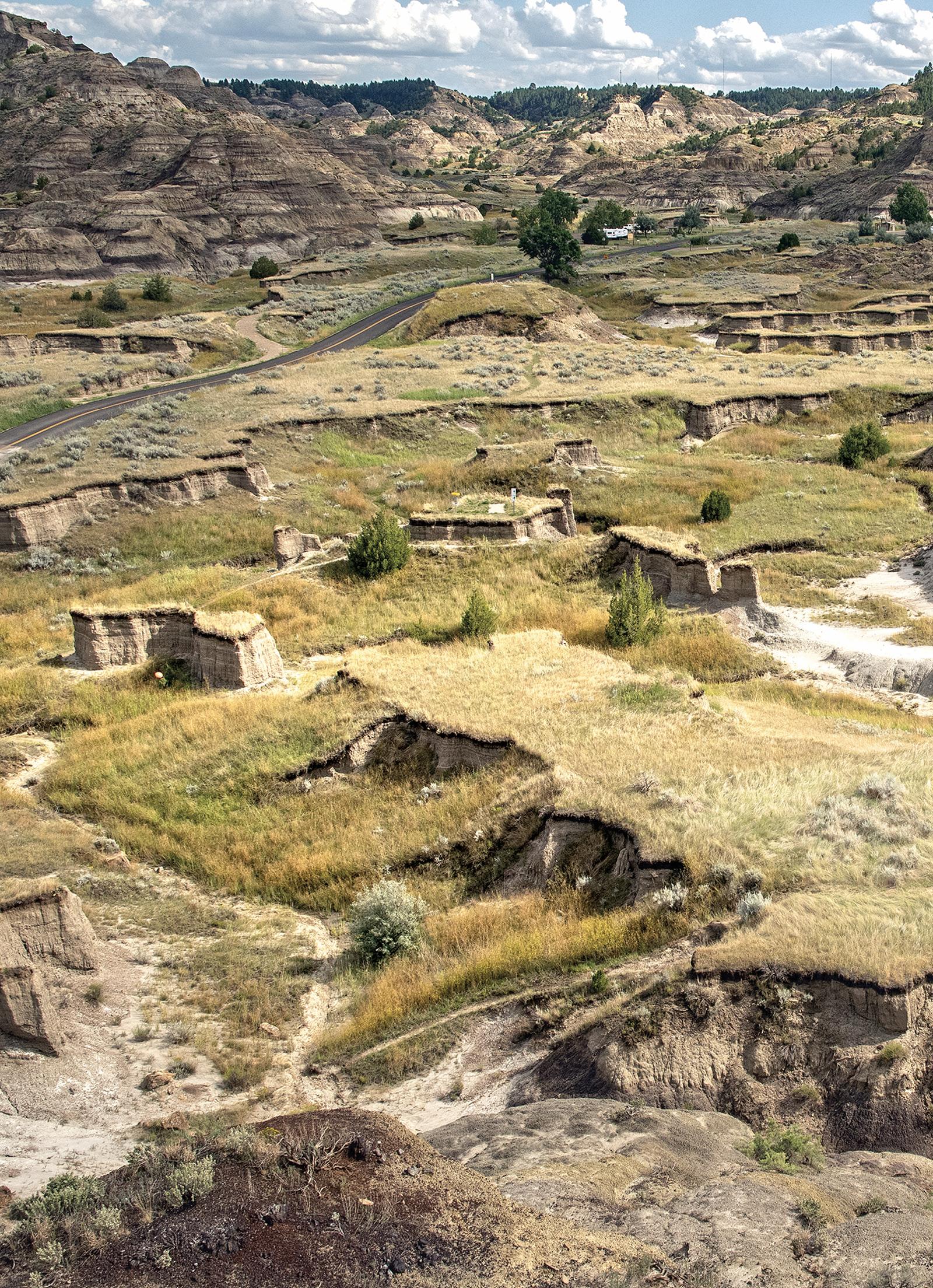
Peggy O’Neill is the chief of FWP’s Information Bureau. John Warner is a photojournalist in Billings.
DINO DISC GOLF Local Glendive resident Dean Curtis launches his driver disc on the 18th hole of the p course while son Daniel and friend Shane Bishop look on. The course offers two levels of play: a 4,993adhering to the Professional Disc Golf Association’s rules of play, and a 4,972-foot 18-hole par 3 “red le online at every disc course in the country,” says Curtis. “There’s nothing like this anywhere.”
The park is a huge economic driver for this region, and with investment from the state, the sky’s the limit for what Makoshika could be as a tourist destination.
park’s unique and challenging disc golf -foot 9-hole par 4 “blue level” course evel” recreational loop. “I’ve looked


When people get here, they always say, ‘I didn’t know you had all this!’ Makoshika is a destination, not just a stopover. You come here to do things.”
sagebrush, Rocky Mountain juniper, stunted ponderosa pine, and other native vegetation. In June, the rugged landscape is dotted with colorful prairie wildflowers. In winter, snow on the bluffs and mesas highlights the undulating badlands topography.
Makoshika is considered one of North America’s premier badlands, with more distinct rock formations than almost anywhere else on the continent. One origin theory is that an ancient prairie wildfire burned so hot it exposed sand and clay soils to the erosive effects of water. Eons of erosion exposed the Hell Creek sedimentary layer, which holds most of the dinosaur bones, and the Fort Union Formation, which contains ancient fish and mammal fossils.
Visitors may not dig for, touch, or remove any fossils in the park. But reporting finds is encouraged. “If someone stumbles across something especially significant, we bring in experts from the Museum of the Rockies,” Dantic says.
Dantic also manages three other Montana state parks: Pirogue Island (80 miles southwest), Medicine Rocks (100 miles south), and Brush Lake (140 miles north). Like FWP’s game wardens and wildlife biologists in expansive eastern Montana, the park manager logs a lot of highway time. Dantic says his job requires “wearing 14 different hats”— from improving roads and maintaining campgrounds to providing visitors with information and planning for the parks’ future.
Dantic is especially proud of Makoshika’s paleo lab, which he helped revive. “It was always here, but not functional,” he says. Dantic worked with the Museum of the Rockies to organize and catalogue the collection of more than 1,000 fossils found within the park that had been gathering dust in storage for years. He also hired a paleo lab manager and provides internships to college students studying paleontology. “When people get to Makoshika, they always say, ‘I didn’t know you had all this!’” he says.
It’s not just the state park’s paleo lab that causes visitors’ jaws to drop. Who knew you could play disc golf among dinosaur fossils? Who ever imagines watching movies outdoors surrounded by badlands rock formations? “Makoshika is a destination, not just a stopover. You come here to do things,” Dantic says.

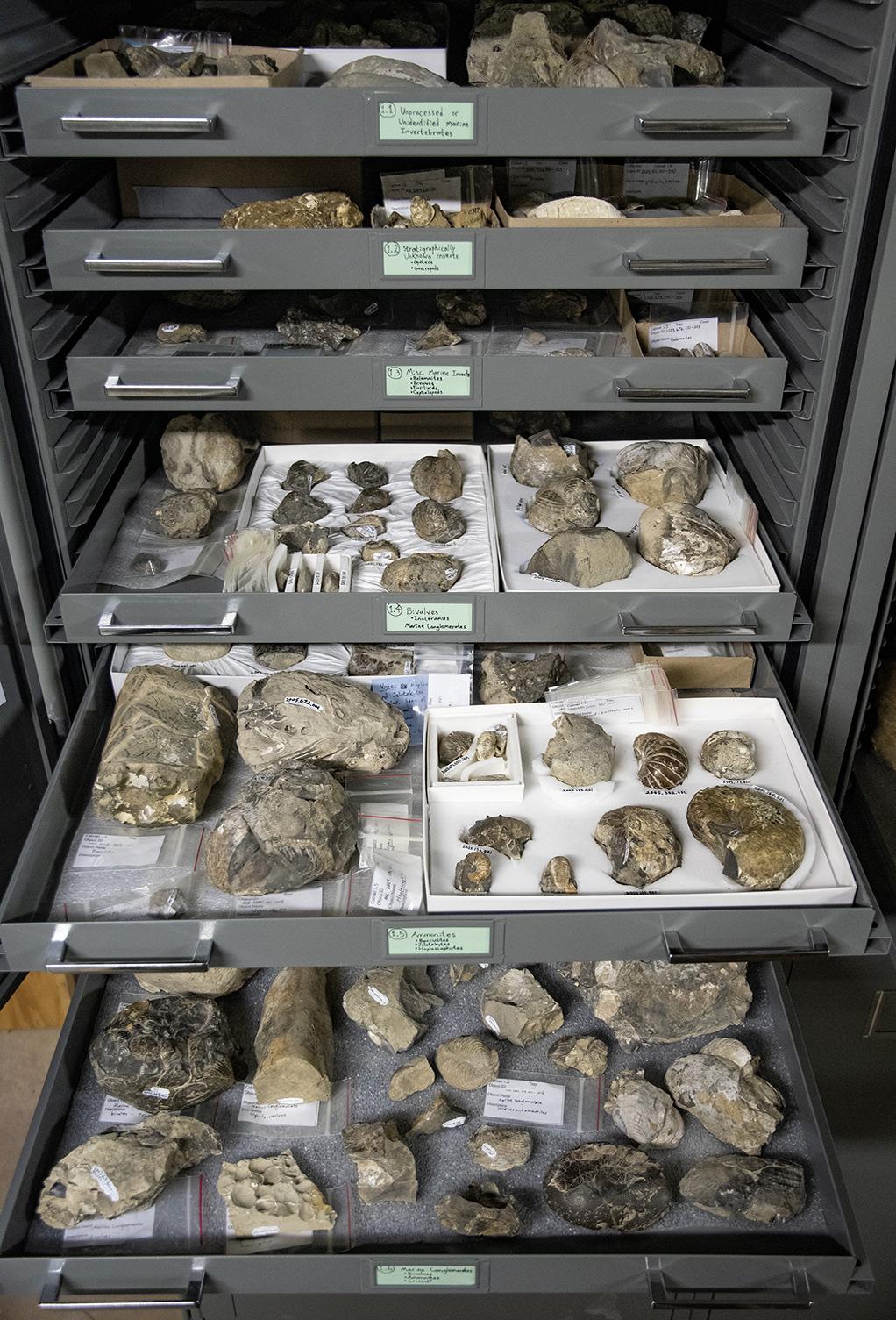
NO SWIMMING TODAY Top left: Park ranger Brenlee Shipps talks to visitors about the mosasaur, an aquatic dinosaur that 66 million years ago swam in a vast sea covering much of the region. Top right: Donations from the Montana History Foundation and Friends of Makoshika have allowed the park to organize, label, and store its fossil collection in a museum-grade drawer system. Below: Teenagers from a youth group in nearby Sidney pose on the park’s natural rock bridge. Groups of young people from throughout the region visit the park to take part in dinosaur and paleo education programs and hike the park’s 11 established trails, like the scenic Cap Rock Trail.

BETTER ROADS A $1.85 million road project completed in 2019 improved vehicle access for the nearly 100,000 people who visit Makoshika each year. Local economic developers hope to convince state lawmakers to allow nearby Glendive and surrounding communities to enact a resort tax that would help them mitigate the effects on local roads and other infrastructure from that annual influx of visitors.

WEAR AND TEAR
That’s a mixed blessing for the city of Glendive and surrounding counties. Makoshika’s nearly 100,000 annual visitors stay at local hotels and campgrounds, shop in grocery stores and at other retailers, and eat in restaurants. Jason Stuart, executive director of the Dawson County Economic Development Council, says Glendive is one of only a handful of Montana cities with enough motel stays (and resulting revenue from the state’s accommodation “bed tax,” used for tourism promotion) to qualify for a local Tourism Business Improvement District and a Convention and Visitors Bureau. “The park is a huge economic driver for the city and the entire region,” he says.
Yet those tourists also strain the city’s infrastructure. “The only way to reach Makoshika is through downtown Glendive, which means lots of big RVs and fifth-wheel campers rumbling down our main street, down two residential avenues, and then down another residential city street before they get there," Stuart says.
Unfortunately, Glendive has no way to collect money from those tourists to mitigate the effects of road wear and tear. Stuart would like to see Montana’s tax law reformed to let tourist-heavy cities like Glendive enact a resort tax. He’d also like Montana to inject more funding into Makoshika and the entire state park system. “With investment from the state, the sky’s the limit for what Makoshika could be as a visitor destination,” Stuart says. “And if a resort tax or local option tax could be implemented, the city could use those revenues to better maintain and improve streets, water, sewer, sidewalks, and new and improved city trails, as well as local first responders and emergency services. It would no doubt be a great boon to the city’s thinly stretched budget.”
NEVER TOO OLD
At the end of the paleo tour, with Max satisfied and talked out, Shipps tells me how she ended up at Makoshika. The 23-year-old graduated with a degree in earth science and minors in paleontology and English. She plans to start a master’s program in paleontology at Idaho State University, but first she’s taking time off to encourage kids to learn about dinosaurs. “But dinosaurs aren’t just for kids,” she adds. “You never have to grow out of dinosaurs.”
I agree. Dinosaurs were the most remarkable creatures that ever lived on this planet. Some were ferocious, others bizarrely shaped, others so big they make elephants seem puny. Many exhibited behaviors and adaptations that scientists are still trying to puzzle out. And then, in a geologic blink of an eye, they disappeared, leaving behind only their feathered brethren, the birds.
What’s not to marvel about dinosaurs, no matter your age? And at Makoshika, it doesn’t take much imagination. There’s evidence of their fascinating multimillionyear history everywhere you look.
The tenderloin, that curious and tender tube of meat tucked under the backbone, is traditionally the first cut I’ll cook from a freshly killed deer. My kids, who call it “gut steak,” grew up devouring it the same day as the hunt, seasoned and blackened in cast iron or seared to savory perfection on a grill. Far from home, I’ve roasted fresh tenderloin skewered on sharp sticks, the juices sizzling into a campfire and scorching my fingers as I, too, eagerly feasted on the meat.
I continue this tenderloin ritual even as chronic wasting disease (CWD) has recalibrated my relationship with deer. But it’s no longer a same-day feast. Instead, I delay gratification until receiving confirmation from a diagnostic test that the deer that produced the tenderloin and other cuts is free of this unkind disease, which stalks healthy animals and kills them, slowly and inexorably, by eroding microscopic holes in their brains.
These tests are elective and precautionary—and free to Montana hunters—but they hit on the most insidious aspect of CWD. While there is no evidence that humans have contracted the brain-wasting disease from eating infected venison, almost all medical professionals warn against eating meat from diseased deer, elk, or other animals (and Montana Fish, Wildlife & Parks supports those recommendations). Health experts say that, although it hasn’t happened yet, they can’t rule out the possibility that a hunter could get sick from eating a deer that carried CWD. The human variant of the disease, called Creutzfeldt-Jakob disease (or CJD), is hideous in the creeping insanity and hollowing death it brings to those who contract it.
But, as we do with other frightful things we can’t see—including Covid-19 and colon cancer—it’s far easier for humans to dismiss the potential for affliction than it is to change our behavior when faced with only a small chance of dying. What’s more, the math of CWD in Montana sides with laxity: Of the more than 96,000 deer that hunters harvested in our state last year, 6,977 samples were submitted for CWD testing (including road-killed deer and samples from moose and elk) and 142 were CWD-positive, for a statewide infection rate of 2 percent. That rate is influenced by hot spots around Libby and parts of northeastern Montana where FWP has intensively tested deer. Statewide, prevalence remains relatively low. Plus, since there’s no record of a human ever becoming sick from eating a CWD-infected deer, not just in Montana but in states where the disease has existed for decades, my buddies have a point when they eat their untested deer and question my caution.
Indeed, testing requires steps that hunters never needed to take before CWD became an issue. First, locating the puttycolored glands in the throat of a deer—the retropharyngeal lymph nodes that concentrate the bent proteins signifying CWD—is challenging the first few times. Then you need to visit the FWP website to find instructions for submitting a sample. Test results from node biopsies can take weeks.
In the meantime, I freeze my venison, wrapping whole haunches in unscented garbage bags and labeling them, waiting to defrost and butcher the meat once it tests
clean. I wrap the tenderloins separately. When given the epidemiology green light, they are the first cuts I thaw, celebrated as a sacrament to wild deer and healthy meat and a tangible reminder of the successful hunt.
I’ve tried to imagine how I’d feel if my deer tested positive for CWD. I’d probably follow public health agency guidelines that recommend throwing infected venison in a landfill, and curse the disease that has the awful ability to turn a year’s worth of beautiful meals into a biohazard.

A TOUGH CALL Hundreds of Montana hunters have made the hard decision to discard their venison after finding out it’s infected with CWD. Most have learned the results from FWP staff, who try to call all hunters whose game tests positive to deliver the news personally, answer questions, and strongly recommend they dispose of the infected meat.
One hunter who received such a call is Addison Idler, a 13-year-old northeastern Montana hunter whose deer, a 3x3 muley buck, tested positive for CWD last fall. Idler didn’t find out the test results until after her family had eaten the backstraps.
“We were so proud of her that we wanted to celebrate with a meal,” says her father, Ky. “We didn’t want to wait for test results, partly because we didn’t think it was positive. It was a young buck and it looked healthy. But after we got the call, we threw the rest of the meat in the landfill. It’s made us question if we should hunt another area or even not hunt at all and just leave the deer alone.”
Such questions make wildlife managers shudder. FWP and wildlife conservation agencies in the other 25 states where CWD has been detected in deer, elk, or moose walk a fine balance. They caution hunters to take CWD seriously, have their deer tested, follow carcass-care guidelines, and discard infected meat. But they also don’t want the fear of CWD to scare hunters away from deer and deer hunting. Hunting is an important
cultural tradition, a source of food for many families, and the main way agencies like FWP control the size of deer and elk herds.
It’s also an important tool for managing CWD prevalence. To contain the disease, wildlife agencies use hunting to lower population densities, reduce deer numbers in infected hot spots, and lower buck-to-doe ratios (because the wider-ranging males are more likely to spread the disease). CWD is less likely to infect a larger proportion of the population when total abundance and buck-
to-doe ratios are lower.
Tom Hauge has been walking the line between safety and hunting for two decades. Now retired, Hauge was the wildlife chief for Wisconsin’s Department of Natural Resources when CWD was first detected there in 2002. It has since spread across most of the state’s southern half. In some counties, up to a quarter of all deer tested carry the disease, mainly because the state was unsuccessful in containing CWD back when only a small percentage of deer carried it. “Hunters resisted killing and testing deer, and it got out of control,” Hauge says. “Take my county, Sauk County, near Madison. Last year, 994 deer were submitted for CWD testing, and 258 tested positive. That’s a 26 percent positive rate. But based on harvest data, we know that only a quarter of the deer harvested in Sauk County were submitted for testing. That means if the prevalence rate holds across all deer killed, then a lot of CWD-positive deer are entering the food chain that nobody knows about.”
So far, there hasn’t been a single case of a human contracting CWD or the human variant, CJD, from eating infected venison in Wisconsin, or in Colorado or Wyoming (two states where CWD was discovered in wild mule deer in 1985), or anywhere else in the world. But that doesn’t mean it can’t happen. Many scientists believe it’s just a matter of time.
Andrew McKean, the hunting editor for Outdoor Life, lives with his family on a ranch near Glasgow. Luke Duran is the art director for Montana Outdoors. CAUTION AND PRECAUTIONS
presence and prevalence of the coronavirus, testing as many deer and elk as possible defines where CWD has spread in Montana CWD is what’s known as a transmissible and how extensively it has infected local spongiform encephalopathy, or TSE. TSEs wildlife populations. are persistent and resistant. Cooking even at “If every hunter assumed that every high temperatures won’t eliminate prions animal they harvested is infected, and then (the malformed proteins), and prions may followed transport and disposal recommenpersist for a long time in soil contaminated dations, we would dramatically reduce the by dead CWD-positive animals and the risk of hunters contributing to the spread of plants that grow there. CWD, and we’d reduce the likelihood of hav-
It’s difficult, though not impossible, for ing the CWD prevalence of states like WisTSEs to move from other animal species to consin,” says Brian Wakeling, FWP’s Game humans. It happens with bovine spongiform Management Bureau chief. encephalopathy (mad cow disease) in cattle. Testing is also a measure to reduce the And the human variant, CJD, also occurred odds that diseased animals enter the human many years ago among some human cul- food chain and create the opportunity for tures that practiced cannibalism.
So caution may not be a bad idea. The first precaution is to Yes, the risk of humans assume that every deer and elk is positive for CWD, and only becoming infected by CWD change that perspective after is low. But prions can evolve, receiving your test results. That means hunters should wear proand with increasing exposure tective gloves and avoid contact comes increasing opportunity with blood, spinal fluid, and brain matter of the deer, elk, or for evolution and adaptation.” moose they kill. They should also avoid spreading CWD to other areas, CWD to jump the species barrier between which is why FWP requires hunters in Mon- deer and humans. tana to leave the spinal column and head of a field-dressed animal in the field or dispose THE DREADED “LEAP” of those parts in an approved landfill. It’s here, in the gulf between what is known
Lastly, hunters are encouraged to submit and unknown regarding the risk to human deer and elk for CWD testing. Just as testing health, that agencies and hunters struggle for Covid-19 is the best way to determine the with how to respond to CWD, first detected in Montana’s deer population in 2017, south of Billings. “Yes, the risk of humans becoming infected by CWD is low,” Emily Almberg, FWP’s wildlife disease ecologist, says. “But prions can evolve, and with increasing exposure comes increasing opportunity for evolution and adaptation.” In other words, given enough chances, the possibility of a prion from a sick deer finding a receptive human host increases.
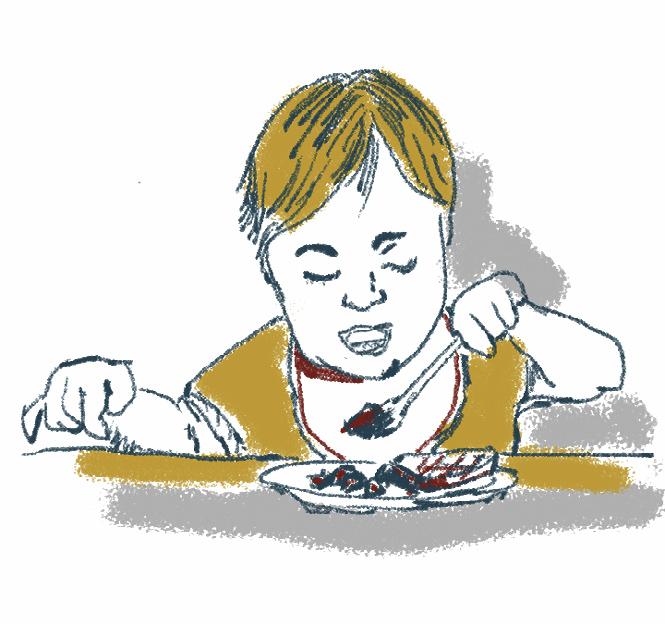

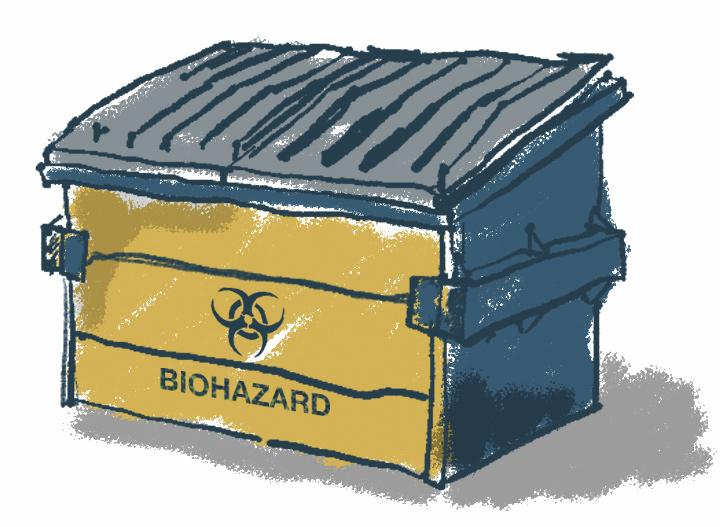
By reducing our exposure to infected deer, we also reduce the risk of an inter-species leap. “Several health agencies, including the Centers for Disease Control and Prevention, have advised against consuming CWDinfected meat because they cannot rule out the possibility that it may at some point find a way of crossing the species barrier,” Almberg says. “We don’t know exactly what the disease would look like, or how long it would take for symptoms to appear in an infected human. The years-long incubation period within members of the deer family may indicate any human infection could also have a long incubation period.”
Epidemiologists point to the outbreak of CJD cases in Great Britain—the widely publicized “Mad Cow” epidemic that killed 178 people in the United Kingdom during the 1990s—and the decade-long delay between those who ate infected beef and detection of human infection. During those years of dormancy, many experts insisted that humans couldn’t get sick from eating infected beef.
“We know now that there was a connection between bovine spongiform encephalopathy and human infection, and that it can be passed via beef consumption,” Almberg says. “In wild ungulates, tissues in the central nervous and lymphoid systems are among those with the highest and earliest concentrations of CWD—that’s why we test lymph nodes. But CWD prions can be detected throughout the body in nearly all tissues, particularly as the disease progresses.”
That’s why containing CWD isn’t a matter of cutting out the infected parts of a deer, and why FWP recommends disposing of the entire carcass of infected animals in certified sanitary landfills.
Back in Wisconsin, Hauge continues to hunt deer with his extended family, but with heightened awareness of the prevalence of CWD around him. “When CWD showed up in the places we hunt, it was like a punch in the gut,” he says. “But we adjusted. We regularly disinfect our knives. We got good at extracting lymph nodes, and with labeling deer until we got test results back. And we dispose of any deer that tests positive.
“I’m old enough that I could probably eat an infected deer and would die of something else before it caught up with me,” Hauge adds. “But I could not in good conscience knowingly feed infected meat to my grandchildren. There’s just so much we don’t know yet, and one of those things is how it affects the body over many, many years.”
As for me and my cherished tenderloins, I maintain my first-bite tradition. If anything, those thawed morsels, once cooked, taste better than ever. Delayed pleasure is pleasure intensified, especially with my all-clear CWD test card cleansing my conscience and sharpening my appetite.

What about brucellosis-positive elk?
Chronic wasting disease isn’t the only wildlife malady with the potential to sicken human hunters. Brucellosis, a bacterial infection that can cause severe flu-like symptoms in humans, is carried by increasing numbers of elk in and around the Greater Yellowstone Ecosystem. Some cow elk infected with the disease abort their calves or deliver weak calves and experience lower pregnancy rates thereafter.
Brucellosis can be transmitted among cattle, bison, and elk, mainly through exposure to reproductive tissues such as placentas, aborted fetuses, and vaginal discharge from infected animals.
Humans can contract a version of brucellosis, known as undulant fever, by handling infected animals, especially bison and elk, says Emily Almberg, FWP’s wildlife disease ecologist based in Bozeman. “For hunters, the biggest risk for transmission is likely at the time of field dressing, when a hunter might inadvertently contact highly infectious reproductive tissues, like the uterus in a cow elk, during the gutting process,” Almberg says. She recommends hunters use latex gloves and eye protection while field dressing, and then wash their hands with soap and warm water and sterilize knives and other gutting gear with a disinfectant such as a diluted bleach solution. Also, don’t open the uterus to check for a fetus, she adds. “That’s where the highest bacteria concentrations are.”
There is also some risk of contracting brucellosis from eating raw or undercooked meat from an infected animal. Almberg notes that all game should be cooked to an internal temperature of at least 165 degrees F. The Centers for Disease Control notes that smoking, drying, or pickling infected meat does not kill the Brucella bacteria or other potentially harmful pathogens. The CDC also cautions against feeding dogs raw or undercooked meat that might contain brucellosis bacteria.
Symptoms of undulant fever are those associated with severe flu, including fever, chills, sweating, headache, low appetite, fatigue, and muscle or joint pain. If you experience prolonged symptoms, and you’ve been in contact with wild animals that may be infected with brucellosis, see a doctor and be sure to describe your recent experience with wildlife. Your doctor will probably order a blood test to detect Brucella bacteria and may put you on a prolonged antibiotic regimen. —Andrew McKean

“OFFICE” WINDOW VIEW A hunting guide leads a string of horses along a trail in a western Montana mountain range. In exchange for the long hours, difficult labor, and seasonal pay, the guides, wranglers, and others who work for outfitters get to spend months each year in some of the state’s wildest places.

It’s noon on the autumnal equinox. Cottonwoods along the Spotted Bear River fly their golden flags, tossed by a wind that holds a bitter edge. Unknown to us, we’re just a few days ahead of a historic late-September blizzard that will dump several feet of snow and drop temperatures well below freezing.
Six of us sit on mules and horses at a U.S. Forest Service trailhead. We feel eager, if a bit uneasy, waiting here on the cusp of the Bob Marshall Wilderness.
The honest truth? Most of what we know about riding we learned from old cowboy movies. But that’s about to change. It’s elk season in the Bob, and we are under the tutelage of riding, hunting, and backcountry experts with Montana Wilderness Lodge & Outfitting for much of the next week.
My three friends and I grew up elk hunting and always prided ourselves on our doit-yourself attitude. Fellow hunters Pat and Cody, a father and son from Wisconsin, are new to the elk game—Cody had never even seen an elk before this trip out West. Novices and old hands alike, we all appreciate the serious nature of a wilderness expedition and know how much we depend on our outfitter, Rich McAtee, of West Glacier. In Montana, hunting outfitters are business owners licensed by the state to provide full-service guided hunts to paying customers. Since running these hunts is typically too big a job for one person, outfitters hire guides and other staff to keep things running smoothly. Guides scout the game and accompany hunters afield, and must also be licensed. In addition, permits are required to run these commercial operations in national forests or other public lands.
On this trip, our team also includes a cook, camp-tenders, and a wrangler who manages the horses and mules. Today, Kaitlyn Casazza and Maddy Snyder, both in their 20s and young enough to be my daughters, are in charge of the string of saddle horses. They will lead the six of us hunters 15 miles to a temporary base camp in the heart of the Bob. Snyder adjusts my stirrups. Too long or short and my knees will suffer, she says.
I wonder aloud how many other details must be in place to avoid disaster with six rookie riders on several tons of horseflesh in one of the most remote, rugged, and wild places in the Lower 48. Snyder, who lives and was raised in West Glacier, shrugs. “It’s not that complicated.” She’s probably just being modest. I guess I’ll have to wait and see.
WISDOM PRESERVATION
People generally think of wilderness preservation in terms of protecting clean rivers, pristine wildlife habitat, and scenery unmarred by industrial development. But wilderness is also a place where we preserve human wisdom, from the routes and vision quest sites still sacred to the Kootenai and Blackfeet, to the woodlore that would have been common a century ago but is evaporating today.
The men and women working as wranglers, cooks, and hunting guides in the Bob Marshall and other backcountry wilderness areas are practitioners of these key skills. Many are young. The work and hours are too brutal for most people over 30. The pay is seasonal and difficult to stretch into a living for someone raising kids and trying to cover a mortgage, truck payments, and insurance.
Yet despite the meager financial rewards, these young adults will saddle your horse, lead you to the Continental Divide, and scratch out a fire under a tree to wait out a snow squall. Maybe find you an elk. Keep you comfortable most days and alive in an emergency.
After that, they’ll even show you how to get the most out of your smartphone.
Wilderness is no more dangerous than
Ben Long is a writer in Kalispell and a longtime contributor to Montana Outdoors.

BALANCING ACT A wrangler carefully distributes weight on pack mules and horses.
STOCK STOP At a base camp in the Bob Marshall Wilderness, guides and camp-tenders unload packs and panniers carried in by pack stock. Understanding and tending to the stock is critical to backcountry work. “We live and die by our horses back here,” says one outfitter.

civilization, but the hazards are different. You won’t get mauled by a grizzly in New York City. But you won’t get run over by a taxi in the Bob, either.
After we arrive at base camp, a Kalispell Regional Medical Center helicopter buzzes overhead. The rescue chopper is looking for a hunter from another camp whose bones were crushed when his horse rolled over him. McAtee waves his arms to signal “all clear here” and the chopper flies off over the treetops.
When trouble strikes in the wilderness, help is often days away. Satellite beacons and rescue helicopters are rendered useless by dead batteries or low clouds. It is rare today to be surrounded by nature’s power and isolated from the technology we typically use to hold that power in check. To me, that feeling, along with the sense of solitude and challenge, is what makes wilderness travel so alluring. It’s a deeply personal connection to wild nature. Some folks find it too difficult or even boring. But that hunger for wilderness is something that first drew me to Montana and has kept me here all my adult life. Here’s the bottom line: There are many easier places to hunt elk than the Bob Marshall Wilderness. But for those of us who come here to do just that, it’s not really the elk we are seeking. Not the elk alone, anyway.
LONG-HELD DREAM
The year 2019 marked my 40th elk season. Since age 12, my hunts had always been backof-the-pickup affairs with friends and family. Any elk I lucked into came out of the woods on my back and those of my companions. It’s given me a keen feeling of satisfaction.
But this approach has its limits. The farthest I’ve packed elk quarters on my back is four miles. That was years ago. I don’t know if I could do it anymore.
Now that I’ve passed 50, I’ve learned that sometimes it’s okay to ask for help. It is not easy to admit you need assistance to achieve a long-held dream. But if you long to hunt deep in the Bob and own no pack stock, I don’t see anything wrong with paying an outfitter to help. Sure, you sacrifice some self-satisfaction. But the trade-off is a wilderness hunting experience you would otherwise never enjoy. Plus you get to meet some inspiring young people.
Grizzly bears have been reduced to just 5 percent of their historic range in the Lower 48. You might say that human wilderness skills have decreased just as much. Yet it’s no coincidence you find both in the Bob.
During our first breakfast in the mess tent, McAtee assigns one guide per two hunters. He sees skepticism on our faces as we eye the three men half our age charged with finding elk and keeping us safe.
“You are in very good hands with these guides,” McAtee says. “Yes, they are young, but they have a ton of energy. They have been doing this all their lives. They grew up in the wilderness. They know the land, they know the elk. But most of all, they know the horses. And we live and die by our horses back here.”
My guide, John Yoder, a man in his 20s who grew up in the lush forests of Lincoln County, wears an oilskin slicker and a cowboy hat and carries a Colt revolver. He’s owned his horse, Star, since he was 12. He
rides smoothly and effortlessly, especially compared to my own awkward, self-conscious horsemanship. Ben Miller, a Kalispell civil engineer who guides during his vacation, and Trevor Hoerner, another twentysomething and a member of a wellknown hunting clan from the Flathead, round out our group’s guiding trio.
UP BEFORE DAWN
That night, the weather turns gnarly, with cold rain and wind, but the guides awake eager to get at it. At 4 a.m. they are saddling horses by headlamps in a downpour. Yoder holds the reins of my mule, Boots, as I strain to get a toe in the stirrup. I pull myself aboard and follow Yoder and my high school hunting buddy Tod Byers of Spokane.
We split off in three parties of two hunters and a guide. Our group stops to water our animals in the nearby river, their shod hooves scraping the cobble under the rushing water. Then we head off, single file, into the darkness to greet dawn at timberline.
The spruce bottom is still entirely dark when Yoder clicks off his headlamp. I put my faith in him and Boots. Riding blind in the rugged landscape yanks me out of my comfort zone and into the exhilarating—and intimidating—zone that is wilderness.
WIELDING THE MISERY WHIP
Wilderness elk hunts are iconic Western experiences, first popularized by a young Theodore Roosevelt who, before he got into politics, wrote a memoir called The Wilderness Hunter. In 1893, the book received rave reviews in the New York Times and planted images of pack strings and elk meadows in the American imagination.
More than a century later, backcountry guides and wranglers carry on that tradition. “These young people embrace the wilderness lifestyle fully,” Mac Minard, executive director of the Montana Outfitters and Guides Association, told me recently. “Few are part-timers who flit in and out. They are dedicated all the way.”
Becoming a Montana hunting guide is fairly straightforward. You must be at least 18 years old, be sponsored by a licensed outfitter, and pass a basic first-aid test.
BASE CAMP BASICS Facing page, top: Camp-tender Kaitlyn Casazza, who was raised and lives in West Glacier, splits firewood to prepare the base camp for an approaching early season blizzard. Rows of tack (facing page, bottom) hint at the complex logistics behind every wilderness pack trip. In the backcountry, horses and mules are essential for carrying gear, food, and hunters to the base camp, and then packing all that—plus, if all goes well, meat and antlers—back out. Below: As snow begins falling outside, hunters and outfitter team members keep their spirits up in a cozy mess tent.

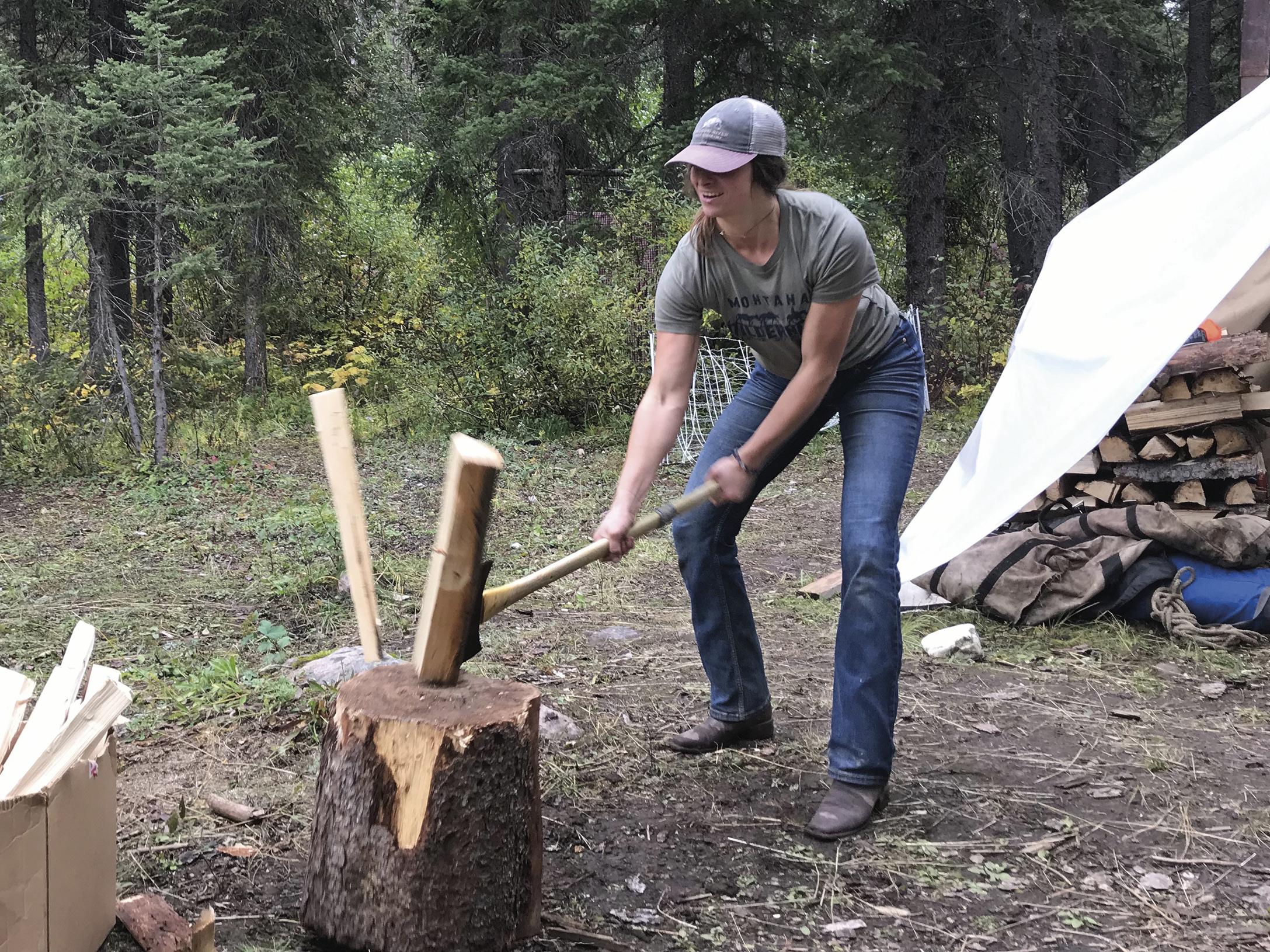
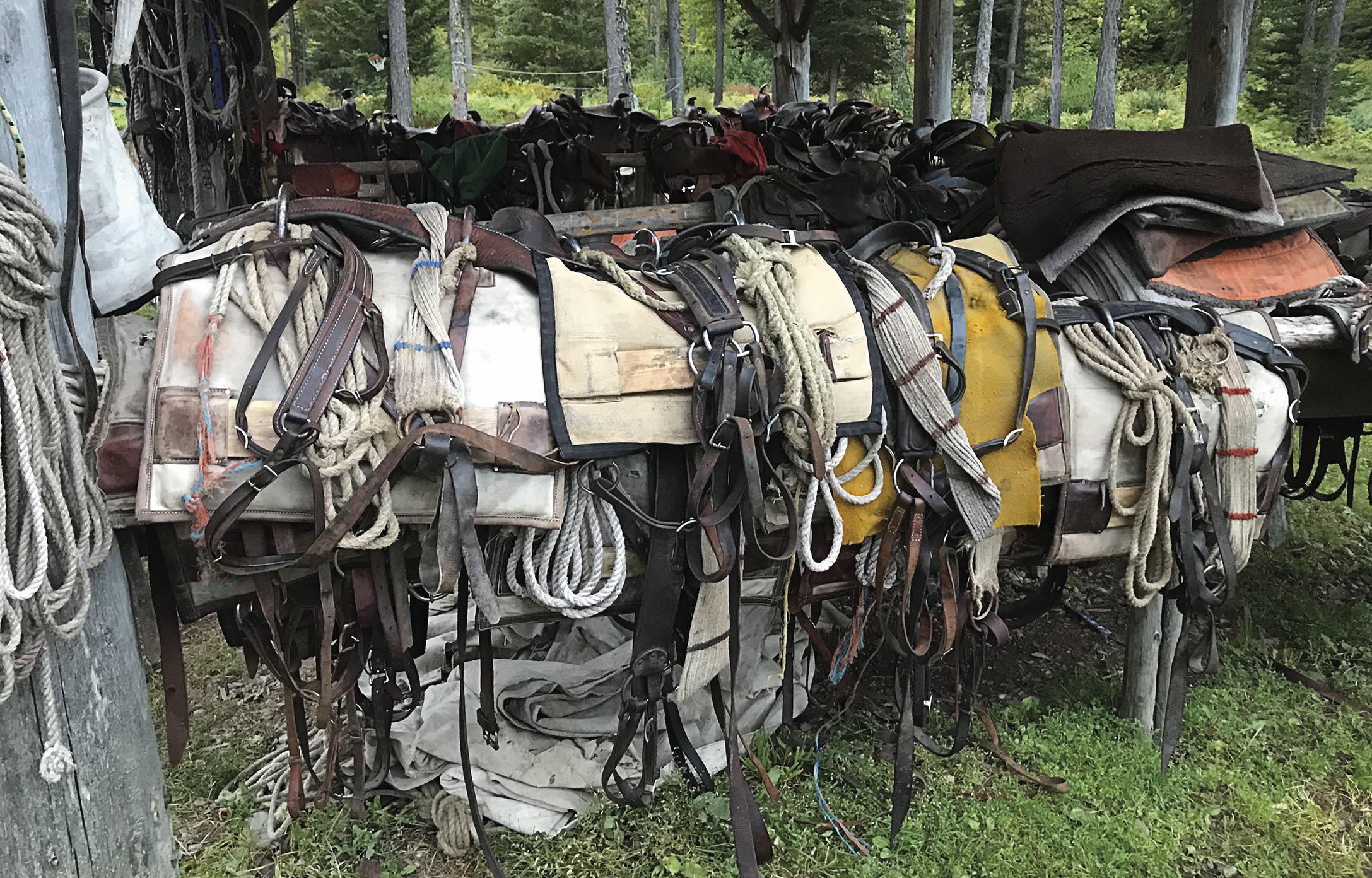
WAY BACK IN IT Hunting guide John Yoder leads the author and his hunting companion over the Continental Divide in the Bob Marshall Wilderness. Guiding in the backcountry requires expertise with pack stock, emergency first aid, wilderness survival, and, of course, finding big game animals.

But becoming a skilled wilderness guide is another matter. Four-wheelers, chainsaws, and other motorized devices aren’t allowed in designated wilderness. The terrain is more rugged. Grizzly bears are more common. Help is more distant.
The job description for a backcountry guide defies the modern syllabus: clear trails with a “misery whip” (crosscut saw) and hone it when dull; secure panniers to packhorses with a California diamond hitch; keep the hunters and stock healthy and happy; and fell and buck firewood with Pulaskis and double-bit axes.
You also need to be able to start a fire when the stove has two inches of standing rainwater in it; keep bears and packrats out of the grub; and negotiate vast tracts of roadless wilderness, across rivers, up and down cliffs, often without trails and in the dark.
Then there’s the hunting aspect. Backcountry and frontcountry guides must know Montana’s hunting laws inside and out. (The last thing they want is for clients to be fined or have hunting privileges revoked.) They need to know how to cook and keep a clean camp. How not to get lost, and what to do if that happens. How to set a broken leg and administer CPR. How to find elk, deer, wild sheep, mountain goats, or other big game and then help the client (who may have never even seen that species before) sneak within range. Guides must judge if the animal has the horn or antler size, or is of the correct sex, to be legal for that hunting district and allowable under the client’s license or permit. They have to coach the client through the shot (“Wait…wait…okay, now.”). Then, if all goes well, they need to gut, skin, and quarter the animal, then either sit out the night on the trail or pack the meat into camp well past midnight. Finally, there’s cleaning and cooling hundreds of pounds of meat and transporting it 15 miles to the truck at the trailhead. Repeat the next day. And the next week. No matter the weather.
Also required: consoling dudes with bad knees, sore hips, or poor aim, and coping with the occasional tender or inflated ego and the psychology of strangers under stress. In short, you need a PhD taught only in the mountains.
TIME OF THEIR LIVES
“Wilderness and wilderness preservation is not just about preserving the landscape and preserving the experience, but also preserving the skill sets necessary to get out
there and enjoy it,” Minard said. “Congress had that in mind when it passed the Wilderness Act. They wanted people to retain those skills.”
As a teenager, I bought a copy of Horses, Hitches and Rocky Trails and practiced my diamond hitch with clothesline. But I’ve never owned an animal larger than a Labrador retriever. I thought I wanted to be a hunting guide, but it turned out I lack the drive and desire to guide others on hunts rather than hunt myself. To be honest, I was too unskilled and maybe too selfish to ever work in that profession.
Last September I watched those young Montanans with admiration and amazement. So much work. So much hardship. Yet I also had the sense that they were having the time of their lives. Did I ever have that much energy?
Minard noted that skilled wilderness guides serve more than their clients. Backpackers, anglers, and others who use the wilderness often depend on the trails that outfitters and guides regularly clear. With Montana’s increased wildfires and beetlekilled windfall, clearing trails in the wilderness is a constant and growing chore, especially as U.S. Forest Service budgets get cut year after year.
“But more than that, guides and outfitters are keeping the wilderness relevant to generations of people all across America,” Minard said. “These public lands belong to everyone, and many folks don’t have the experience or the equipment to enjoy the wilderness on their own. Guides and outfitters let them do that.”
According to the Montana Outfitters and Guides Association, Montana has roughly 600 active licensed outfitters. Each year, those outfits hire about 1,700 hunting and fishing guides and hundreds of wranglers, cooks, and other workers. It’s all part of Montana’s outdoor recreation economy. As Montana becomes more urbanized and modernized, it’s harder to find young people with the skills and drive to become wilderness guides. “Just like any other business, hiring and retaining good, skilled employees is the single biggest challenge,” Minard said. Likewise, it seems that fewer hunters want to follow the trails of Jim Bridger and Teddy Roosevelt. “The true wilderness hunting experience is rigorous. It’s not for everyone. It’s entirely different from riding around in a pickup truck and sleeping in a bunk house,” Minard told me.
IT IS INDEED COMPLICATED
Millennials are often unfairly dismissed as spoiled, lazy, unmotivated, and self-centered. Such complaints are as perennial as grass, repeated by one generation after another.
Don’t believe it. Many kids still follow their hearts deep into the wilderness, just as young people have done for generations. And these young Montanans have the grace and generosity to share what they learn with others.
Five days after embarking on our wilderness pack trip, three of the six hunters had to head back to civilization. Pat and Cody from Wisconsin and I had lucked into elk the first day of the hunt. We had three bulls—two 6x6s and a 5x6—to contend with. I left my three high school buddies to continue hunting, despite the deteriorating weather. They would race the snowfall to the trailhead a few days later, with nothing but tales of adventure to recount.
For our fortunate trio there was elk meat to be cut, wrapped, and put in the freezer. Families members to see. Deadlines and meetings beckoned. I was reluctant to leave, but the barometer and the snow line were both dropping as the approaching blizzard built steam.
Leading the pack string back to the trailhead, the stock laden with quarters and antlers, was Snyder, the same woman who led us in. Back on Day 1, she had said that wrangling pack stock isn’t complicated. I admired her nonchalance, but what I witnessed proved otherwise. Running a pack string requires proficiency at tying complex knots and hitches; exactly balancing pack boxes or bag loads on both sides of horses and mules; lining up stock based on each animal’s experience, temperament, and aptitude. Wranglers know which horses and mules are lazy or goofy, which ones spook easily or nip, and which ones lead and tie well.
Any mistake could send hundreds of pounds of gear and game meat—not to mention clients—tumbling into a river or down a mountainside.
It’s perhaps odd—unnerving, even—that outfitters and their clients put so much trust in people barely out of their teens. Yet the young wranglers and hunting guides accept that responsibility and live up to those expectations.
I was glad to meet them, to witness their skill, humility, and good cheer. It made me hopeful—about young people, about wilderness, and about Montana.
A LITTLE ASSISTANCE The author with a 6x6 bull taken last September deep in the Bob Marshall Wilderness. Though an experienced elk hunter, he realized that a backcountry hunting trip required more heavy labor than his body could bear: “Now that I’ve passed 50, I’ve learned that sometimes it’s okay to ask for help.”
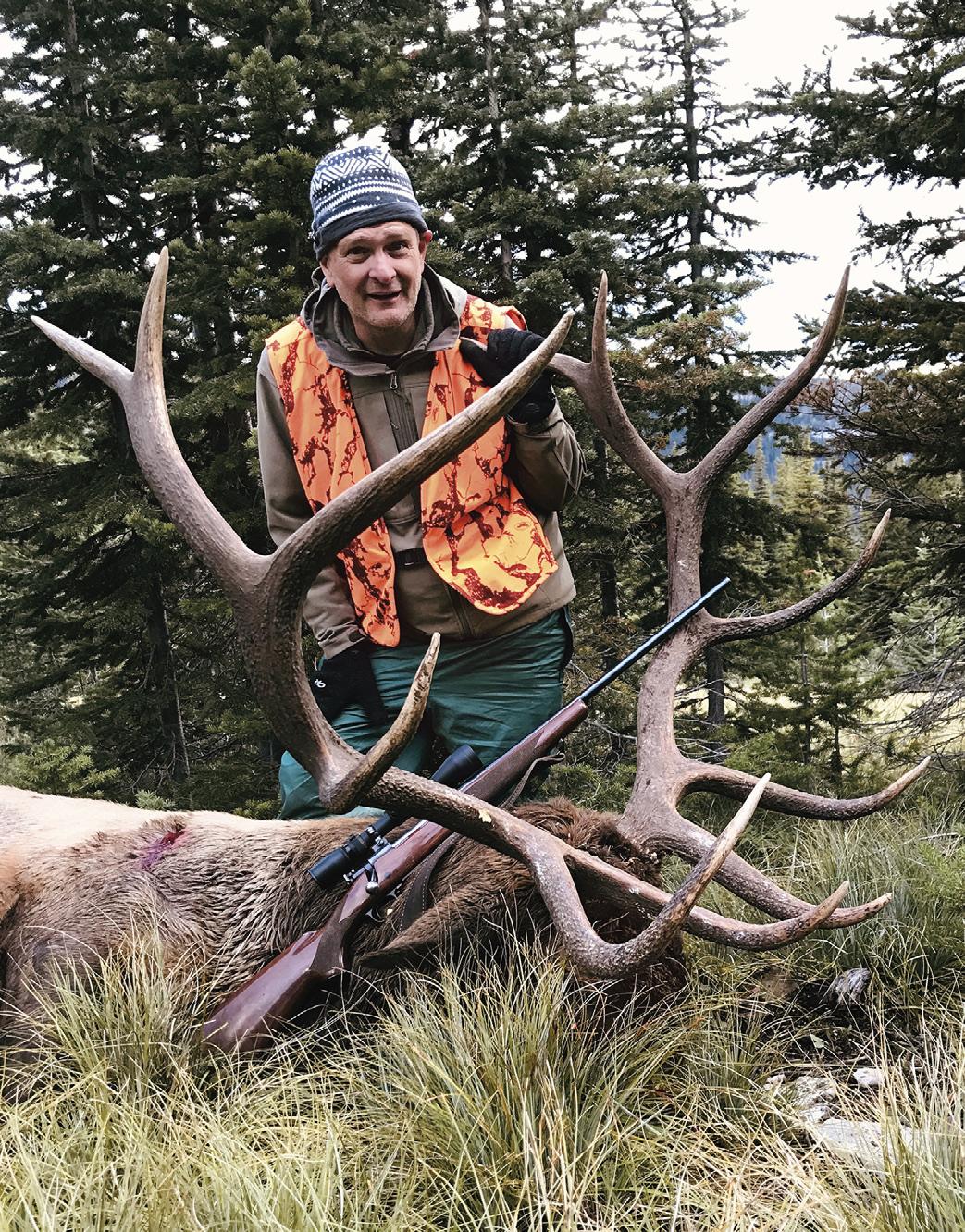


RELATIVE NEWCOMERS Though they now thrive across much of Montana, wild turkeys are not native. FWP stocked the Merriam’s subspecies, identified by light tail feather tips, in eastern and central Montana, and the birds have since spread. The eastern subspecies, shown here, has chestnut brown tail tips and was introduced illegally in the Flathead region. Those birds have expanded their range into other parts of western Montana.

Each fall, my wife and I try to harvest a bird for Thanksgiving dinner. Here’s how we hunt turkeys during Montana’s late season.
jBy Jack Ballard i

hanksgiving and turkey go together fatter and better tasting than their spring favors a more aggressive approach because like the Fourth of July and hotdogs or counterparts, which are just coming off the you stalk the birds rather than wait for them to
St. Patrick’s Day and corned beef. For lean months of winter. (maybe) come to you. And because turkeys in hunters wanting to serve wild turkey to their Then there’s the way you hunt turkeys in eastern Montana live in or near pronghorn, family on Turkey Day, that usually means fall, which for me is the late season’s great- deer, or upland bird habitats, you can combine bagging a gobbler during the traditional est appeal. During spring, the only way to turkey hunting with hunts for other species. spring hunting season, freezing the bird, lure a gobbler to within shotgun range (30 then thawing it for the holiday. yards or less) is to hunker down in one spot WHERE TO HUNT
But there’s another option, one my wife and call a bird close by mimicking a hen Fall turkey hunting is allowed in western Lisa and I have long Montana (Fish, Wildpursued but that few life & Parks’ Regions 1 other hunters notice and 2), where the birds amid the hubbub of are primarily on prihunting deer, elk, vate land, and in the and other big game: state’s southeastern hunting wild turkeys quadrant (Region 7), during the fall. where I hunt and
Chasing turkeys which is packed with in October or No- public land. The fall vember has advan- season in all three retages over hunting a gions runs September gobbler in spring. 1 through January 1. Tags are more read- Look for turkeys ily available. In addi- where you find whitetion to the shotguns tailed deer and ringallowed for spring necked pheasants: hunts, you can also along the edges of use a rifle, allowing pastures and harfor longer shots GUYS NIGHT OUT When not fanned out in their classic mating display, tom (male) turkeys, also vested crop fields near (though Lisa and I stick with shotguns). Unlike the tomsknown as gobblers, are identified by the strand of long fibrous bristles growing from their chest. During the spring season, only toms can be shot. During the fall season, hunters may also harvest hens and young-of-the-year poults. riparian (streamside) habitats. They also like open forests and only spring season, fall hunters can shoot turkey. I can’t do it. Sitting still for extended woody draws where mule deer hang out. toms, hens, and young-of-the-year poults. periods of time is no easier for me at age 57 Like antelope, turkeys rely on exceptional What’s more, autumn turkeys are usually than it was when I was a first-grader. eyesight to spot danger. Unlike antelope, they With the exception of using the kee-kee rarely venture more than a few hundred yards Jack Ballard is a writer in Red Lodge. run (see page 38), autumn turkey hunting from cover. You might find them feeding in
hay meadows or crop stubble, but usually not far from trees or shrubs where they can scurry to safety if threatened, or to rest after filling their crop.
Turkeys roost at night in the tallest trees they can find. In national forests, that means ponderosa pines. On the eastern plains, turkeys mostly roost in green ash or cottonwoods growing along rivers or seasonal streams.
The 1- to 10-square-mile range of local flocks doesn’t alter much from spring to fall. However, areas within that range where you’ll find turkeys change throughout the year, depending on food sources. In fall, wild turkeys dine from an eclectic menu, which varies depending on what’s available. For instance, prolific hatches of terrestrial insects may draw the birds into grasslands where the bugs are abundant. On one fall hunt near Ashland, I bagged a fat hen that had stuffed herself so full of grasshoppers they were coming out of her beak.
In addition to insects (usually more abundant early in the fall season before frost hits), turkeys feed on berries, seeds, and the succulent leaves of wild strawberries and other green plants. Most agricultural crops are harvested before or not long after the fall season begins. Turkeys soon turn up to feast on remnant corn, wheat, and barley or the regrowth of hayed alfalfa. Turkeys also eat wild plums, chokecherries, and rose hips in the open coniferous forests of the Custer National Forest near Ekalaka and Ashland. Elsewhere the birds are most common in moist draws and ravines containing deciduous trees and shrubs.
Once for a magazine article assignment, I accompanied a trio of disabled Vietnam veterans on a pronghorn hunt in southeastern Montana. After the hunters harvested their antelope and headed for home, I asked the outfitter we’d hired where I might find some turkeys on public land not far from his lodge near Broadus. He pulled out a map and pointed to a few locations in the Custer National Forest. His recommendation led me to an area that’s produced several turkeys over many seasons, but this advice has proved universally valuable wherever I hunt turkeys in the fall: “Find dips and draws with plum bushes and

FALL HARVEST The author with a jake Merriam’s wild turkey shot on public land northwest of Baker a few days after a premature fall season snowfall. “This particular bird was probably the best wild turkey we’ve ever eaten,” he says.
Using the Kee-Kee Run i
If other approaches fail when hunting late-season turkeys, try using the kee-kee run, or call. Employ this tactic if you are unable to get near enough to stationary birds for a shot or can’t pull off an ambush on a moving flock. First, get as close to the flock as possible. Then, with your shotgun unloaded, run at the turkeys and hope they scatter in all directions. Find the nearest cover, sit down, load, and, using a mouth call, say kee-kee-kee or hurry-hurry-hurry to mimic the worried sound of poults trying to find each other. You’ll need to listen to a training video on YouTube a few times beforehand to get it down. That call, along with a few soft yelps, can often entice a poult or hen to come close enough to your hiding spot for you to secure your Thanksgiving
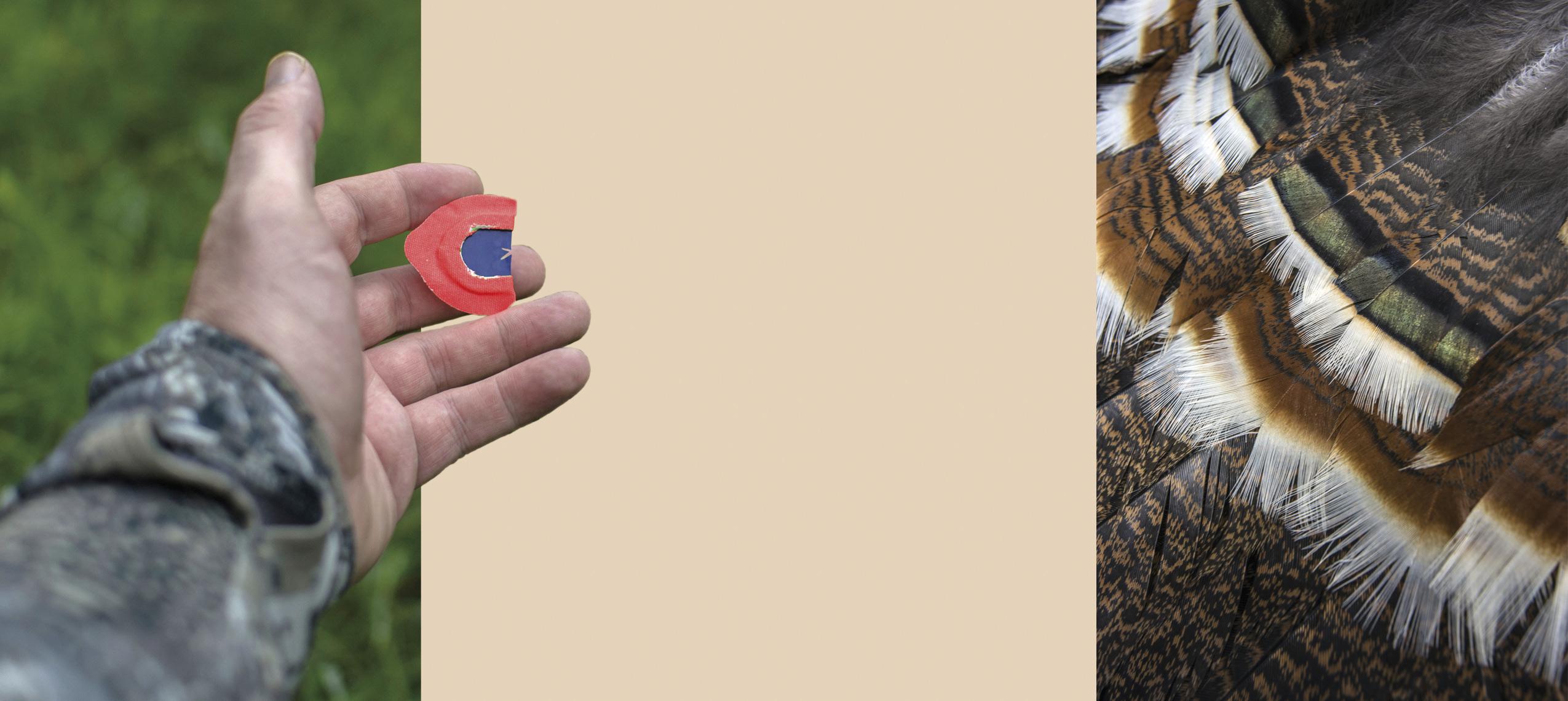
other shrubs, and that’s where you’ll find turkeys,” he said.
HUNTING TACTICS
Spring turkey hunting requires listening. You walk around until you hear a gobbling tom, and then sneak to within a few hundred yards before sitting down to call him in.
But turkeys don’t gobble in the fall, so late-season hunting is all about looking, not listening. One approach is to drive around and glass field edges and riparian areas. Another is to hunt likely habitat and search for sign. Once while hiking up a national forest ravine flanked in ponderosa pines, I discovered intermittent tangles of deciduous shrubs along the bottom. I also spotted a faded turkey feather and the telltale threetoed track dried in the mud on a cow path. Bingo. A half hour later, I spied a half-dozen birds pecking at the soil 100 yards away and was able to creep close enough to make a killing shot with the copper-coated No. 6 lead shot from my 20-gauge shotgun.
If the terrain and cover allow, try sneaking up on a stationary flock of turkeys preoccupied with feeding. Another—and, for me, more productive—approach is to locate a slowly moving flock and get ahead of the birds for an ambush. This requires both speed and stealth. Eagle-eyed turkeys can detect distant movement and bright colors from hundreds of yards, so you need to get in front of the birds without a single turkey spotting your approach. Once alerted by a wary turkey’s Putt! Putt! alarm call, a flock can disappear in an instant.
Turkey movement isn’t perfectly predictable, but a hunter can usually figure out where the birds are going. As evening approaches, they’ll work their way toward a favored roosting site, so head for the closest grove of tall trees. Feeding birds often follow the contour of a slope or move straight uphill or downhill. At daybreak in favorable weather—not too windy or rainy—turkeys almost always make their way to a feeding area after descending from their roosts. Like white-tailed deer this time of year, they wander into open fields and meadows for an hour or so before returning to cover.
Last season Lisa and I spotted a flock at midmorning on a Block Management Area about 50 miles northeast of Miles City. The land was mostly open cattle range and hay fields that you’d never consider prime turkey habitat. But it did contain one wandering draw clotted with green ash trees and chokecherries that looked perfect for turkey roosting, loafing, and feeding. Sure enough, we spotted a dozen hens, a few dozen poults, and a couple of jakes (one-year-old males) drifting toward the draw from a cut hayfield. Lisa and I hustled up the draw, then inched up the bank to where we estimated the birds were headed.
The flock was closer than expected. At 20 yards, Lisa killed a hen and a juvenile, while I bagged a jake. Earlier that day we’d harvested an antelope buck and a brace of sharp-tailed grouse. Now, with three wild turkeys also in the bag, we not only had more meat for the freezer, but also a special treat to cook in the smoker and serve for Thanksgiving dinner.
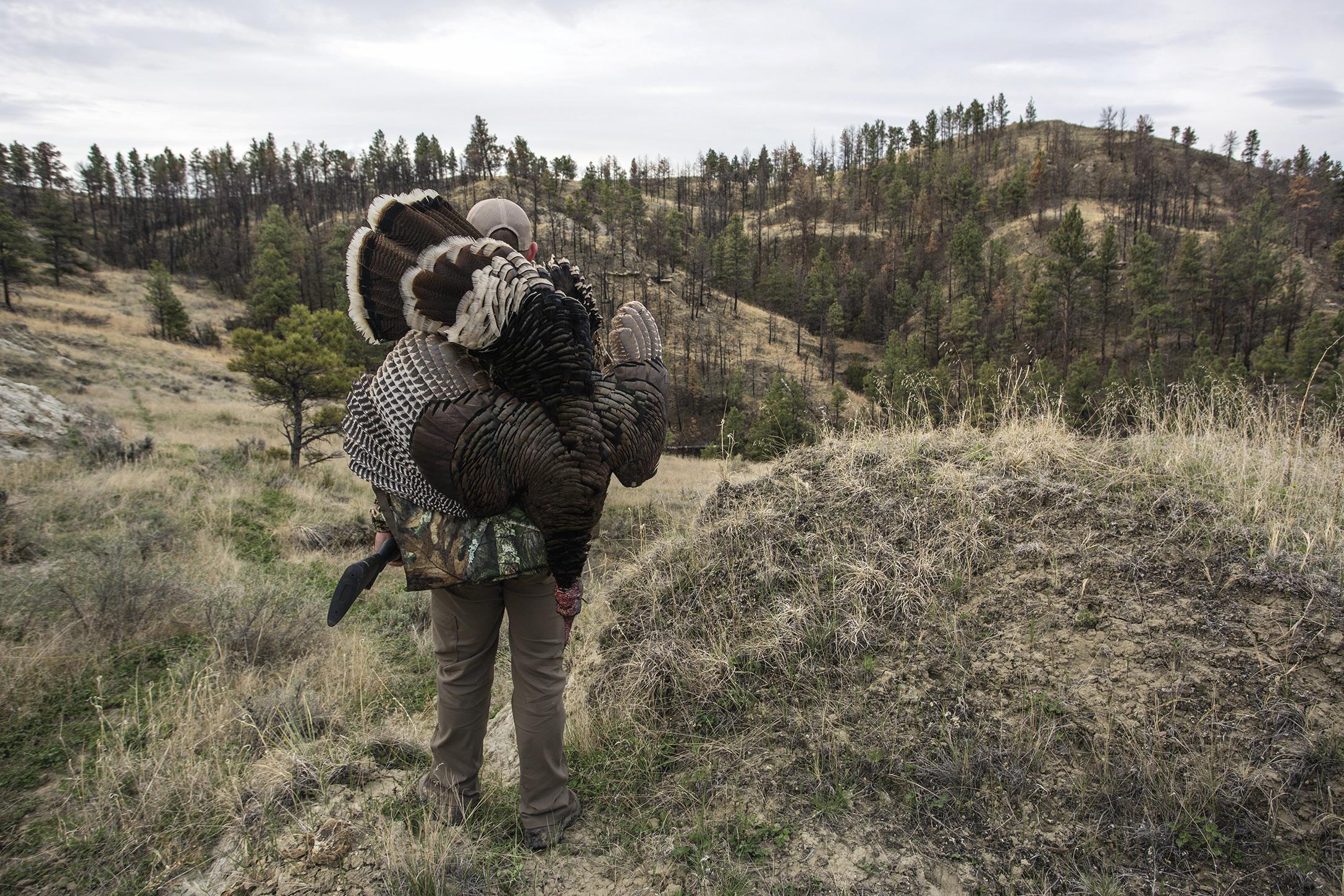
DEER-TURKEY CONNECTION In eastern Montana, many hunters bag a fall season wild turkey in the same forested terrain where they hunt mule deer, or in agricultural areas along streams and rivers where whitetails and pheasants hang out.

